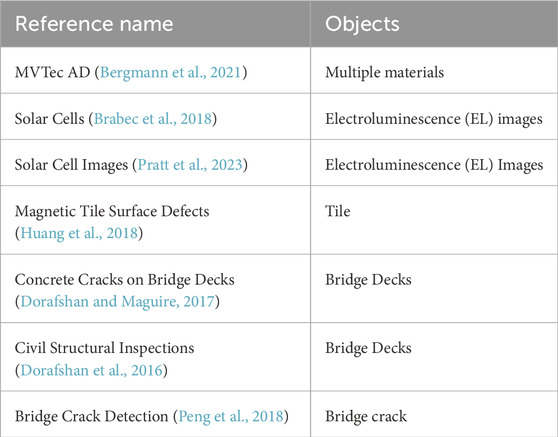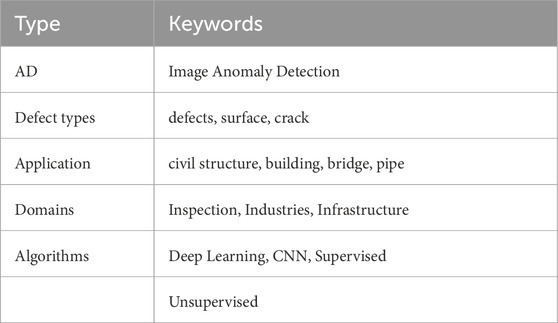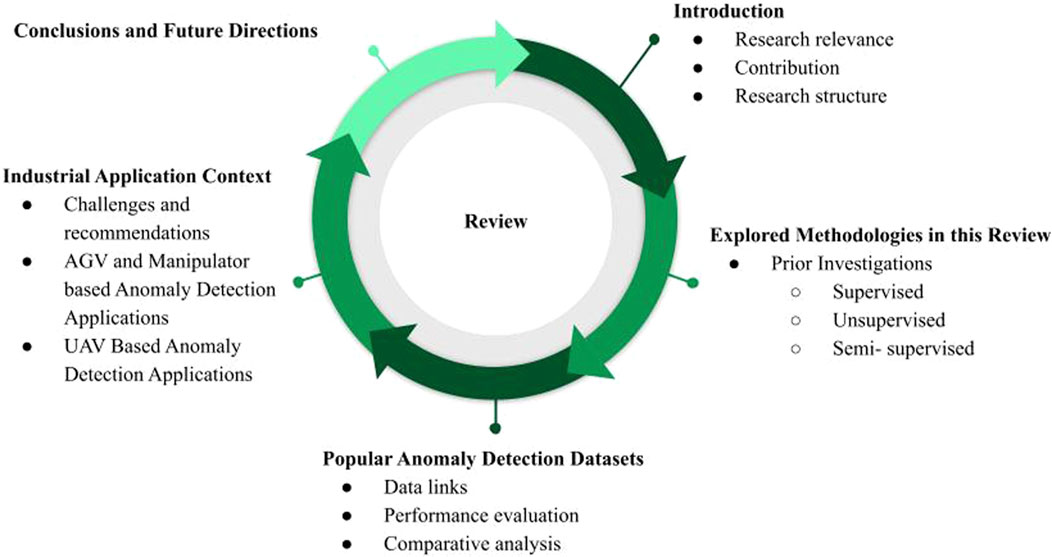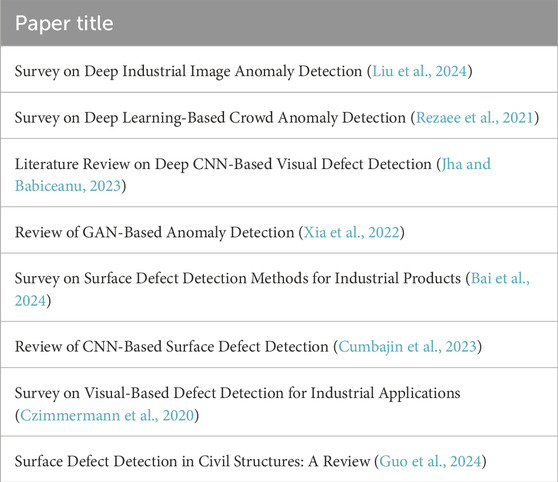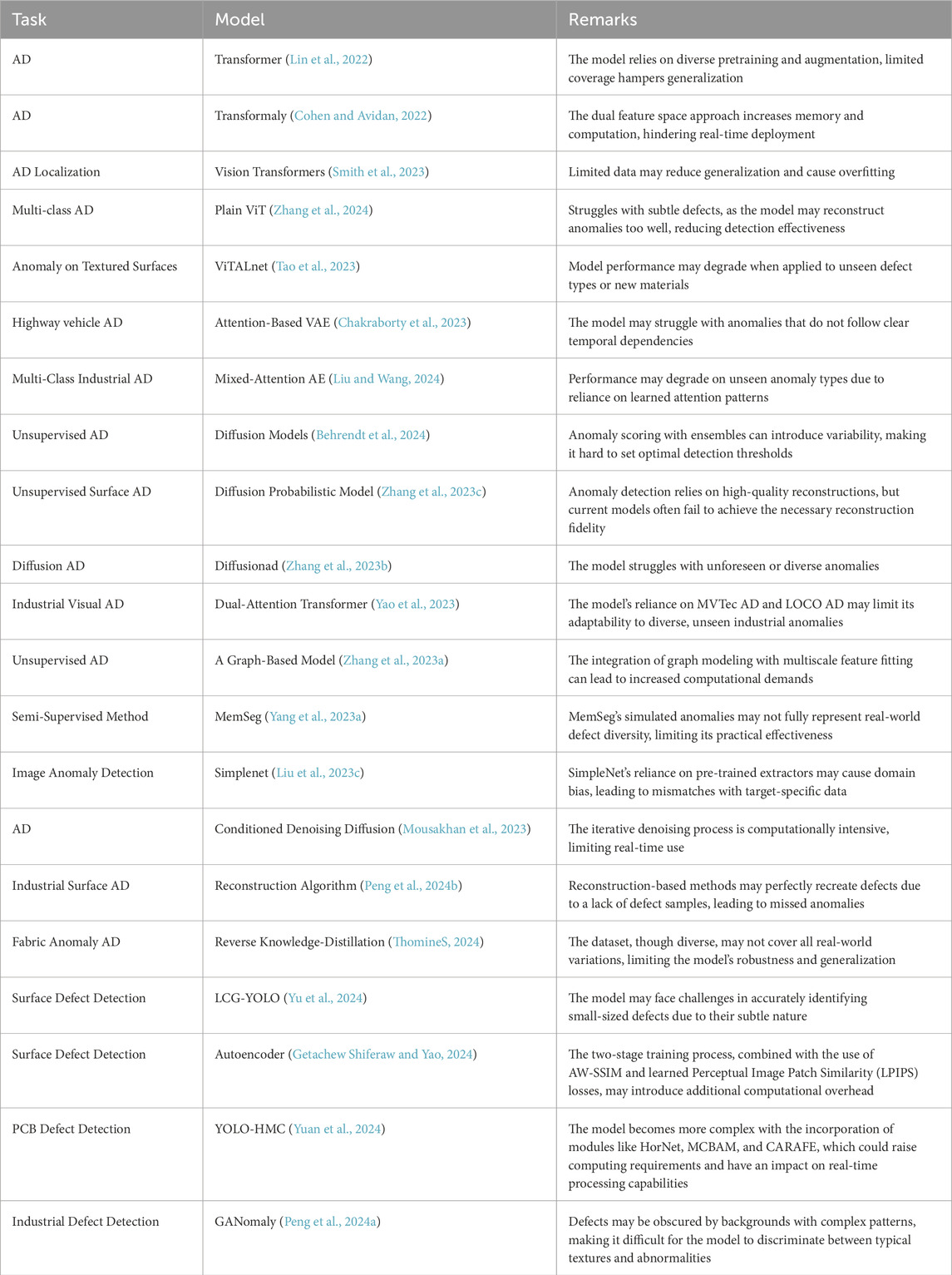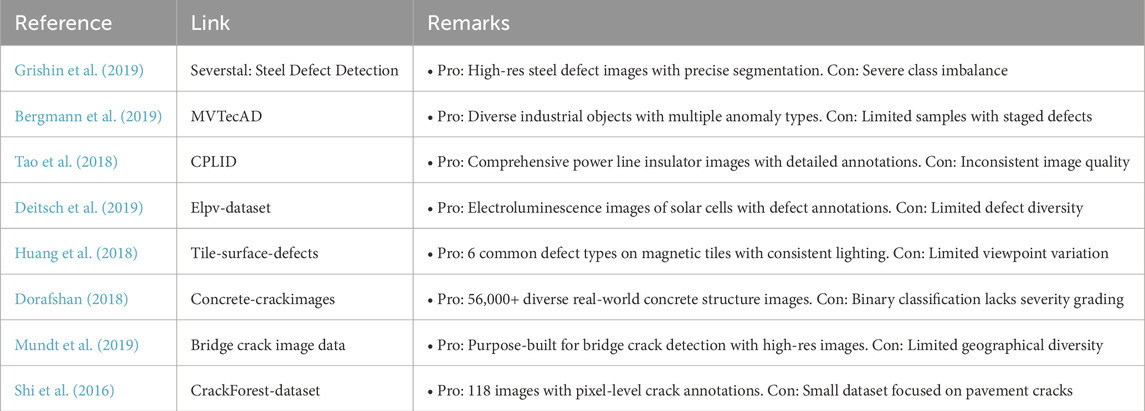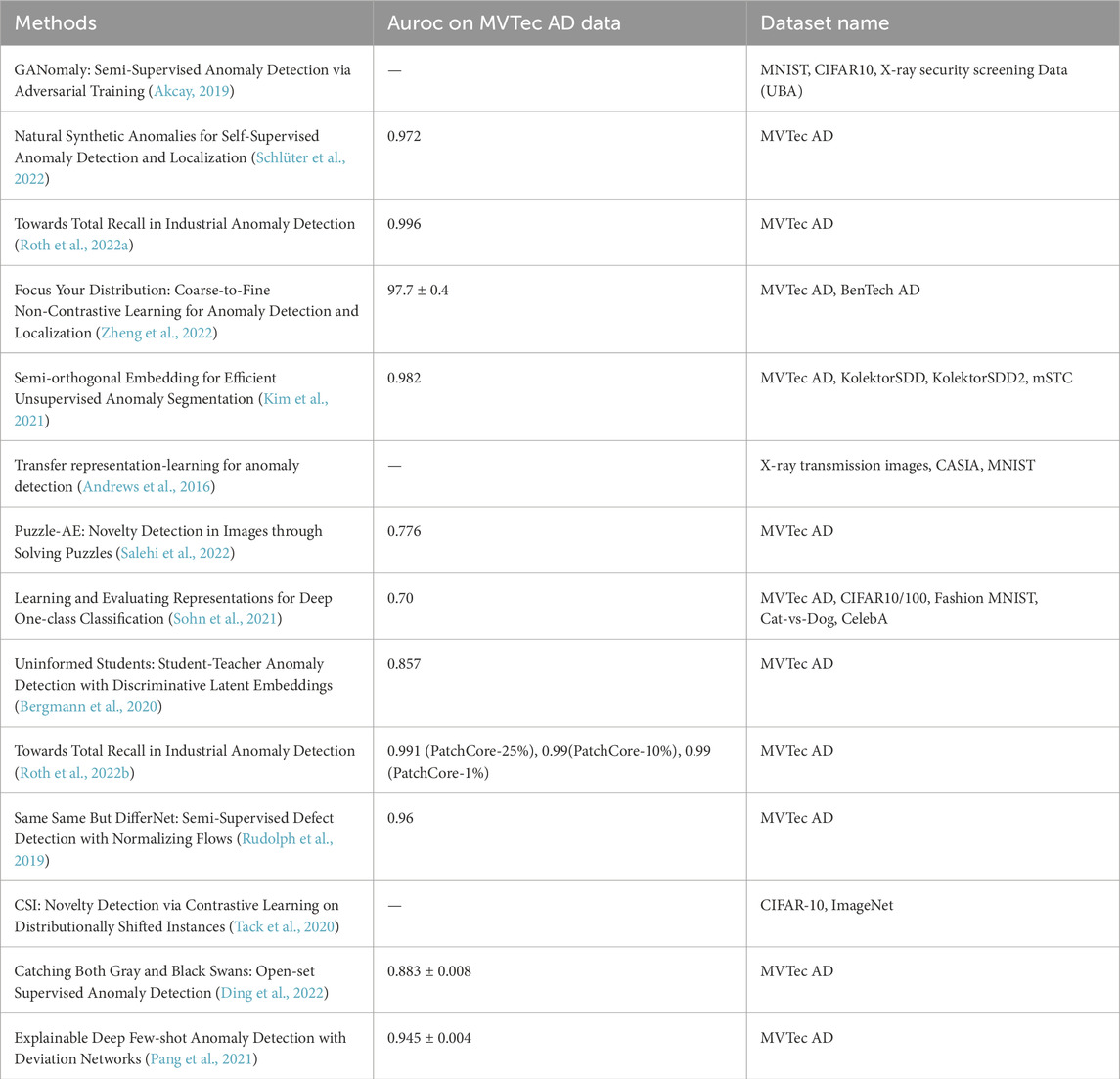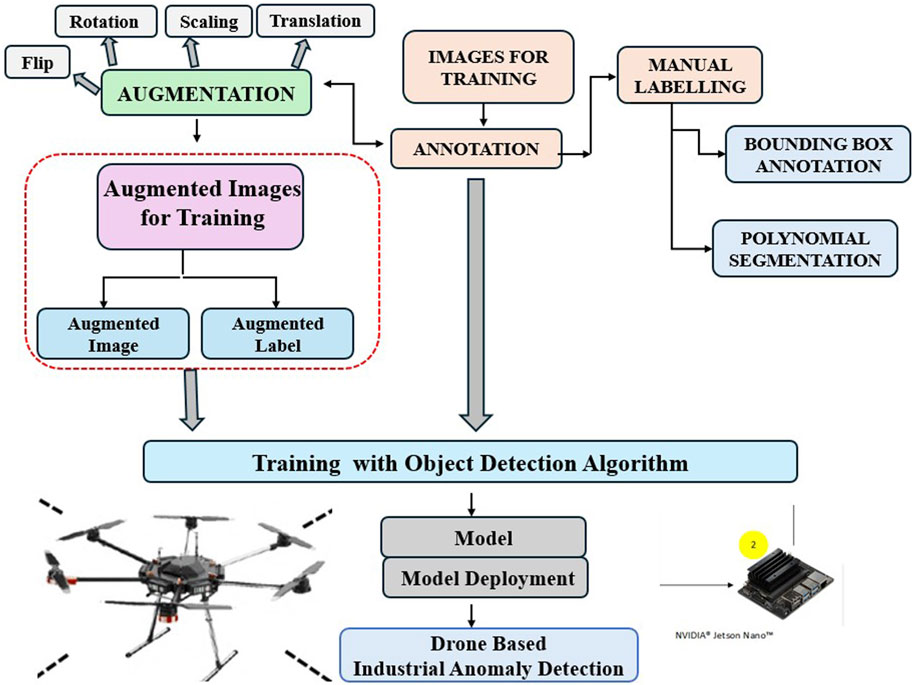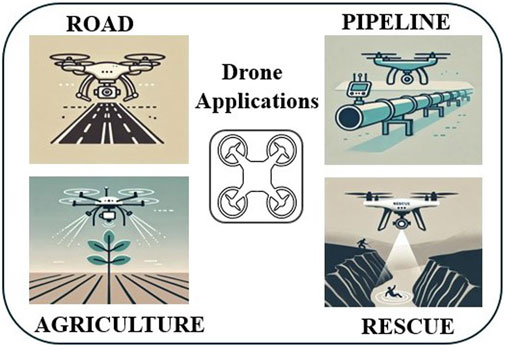- 1Drone Lab, Centre for Artificial Intelligence and Robotics, Indian Institute of Technology Mandi, Mandi, Himachal Pradesh, India
- 2Drone Lab, School of Mechanical and Materials Engineering, Indian Institute of Technology Mandi, Mandi, Himachal Pradesh, India
Industrial automation is rapidly evolving, encompassing tasks from initial assembly to final product quality inspection. Accurate anomaly detection is crucial for ensuring the reliability and robustness of automated systems. The intelligence of an industrial automation system is directly linked to its ability to detect and rectify abnormalities, thereby maintaining optimal performance. To advance intelligent manufacturing, sophisticated methods for high-quality process inspection are indispensable. This paper presents a systematic review of existing deep learning methodologies specifically designed for image anomaly detection in the context of industrial manufacturing. Through a comprehensive comparison, traditional techniques are evaluated against state-of-the-art advancements in deep learning-based anomaly detection methodologies, including supervised, unsupervised, and semi-supervised learning methods. Addressing inherent challenges such as real-time processing constraints and imbalanced datasets, this review offers a systematic analysis and mitigation strategies. Additionally, we explore popular anomaly detection datasets for surface defect detection and industrial anomaly detection, along with a critical examination of common evaluation metrics used in image anomaly detection. This review includes an analysis of the performance of current anomaly detection methods on various datasets, elucidating strengths and limitations across different scenarios. Moreover, we delve into the domain of drone-based, manipulator-based and AGV-based anomaly detections using deep learning techniques, highlighting the innovative applications of these methodologies. Lastly, the paper offers scholarly rigor and foresight by addressing emerging challenges and charting a course for future research opportunities, providing valuable insights to researchers in the field of deep learning-based surface defect detection and industrial image anomaly detection.
1 Introduction
In the complex manufacturing environment of industrial production, ensuring product quality is paramount. Technological constraints and cluttered operational environments can hinder detection of surface defects and anomalies in automation processes, potentially leading to costly product recalls and safety risks. In these complex industrial environments, detecting anomalies in surfaces of industrial components and automation processes is crucial for advancing industrial automation. Over the years, defect detection methodologies have evolved from traditional manual inspection practices to sophisticated automated systems, driven by advancements in computer vision and deep learning.
The emergence of Industry 4.0, characterized by the seamless integration of cyber-physical systems, cloud computing, and artificial intelligence, heralds a new era of intelligent manufacturing. Within this paradigm, the imperative for intelligent defect detection systems becomes increasingly pronounced, poised to revolutionize production processes, elevate product quality, and optimize resource utilization. A key part of this transformation is visual anomaly detection. This involves using powerful computer techniques to examine huge amounts of visual data for small errors or unusual patterns that human perception might miss.
Traditional and advanced defect detection methodologies (Bhandarkar et al., 2024), spanning from manual visual inspection to specialized non-destructive testing techniques, have long served as the cornerstone of quality assurance practices across diverse industrial sectors. However, the advent of machine vision systems, driven by advancements in image processing algorithms and cutting-edge technologies, has precipitated a paradigmatic shift in automated defect detection. This shift has empowered industrial processes with high precision and efficiency in detecting anomalies within visual data streams.
The development of deep learning algorithms, especially convolutional neural networks (CNNs) (O’Shea and Nash, 2015) and recurrent neural networks (RNNs) (Sherstinsky, 2018) has further catalyzed advancements in industrial automation. Cheng (2023), Radford et al. (2018), and Gao et al. (2023) used these machine vision advancements to improve defect detection capabilities, transcending previous limitations by discerning intricate patterns and anomalies with remarkable accuracy. Within the domain of anomaly detection Table 1 provides a detailed overview of various objects that can be identified as anomalies or defects in different application domains. A supervised, unsupervised and semi-supervised learning methods each offer distinct yet complementary approaches for anomaly detection, leveraging labeled and unlabeled data to varying extents to uncover deviations from expected norms.
This review focuses on providing a comprehensive survey of defect detection methodologies, traversing the range of supervised, unsupervised, and semi-supervised learning paradigms. By meticulously dissecting the complexity of each approach, we aim to clarify their theoretical basis, algorithmic frameworks, and practical implications in real-world industrial settings. Through a rigorous analysis and synthesis of existing literature, this paper seeks to distill key insights, identify prevailing challenges, and describe future research directions to propel the field of industrial defect detection towards new frontiers of innovation and excellence.
In the ensuing sections, we embark on a systematic exploration of defect detection methodologies, navigating through traditional machine vision techniques to cutting-edge deep learning-based approaches. We scrutinize the efficacy of supervised, unsupervised, and semi-supervised learning paradigms in anomaly detection, unraveling their intricacies and applicability across diverse industrial domains. Furthermore, we delve into the complexities of dataset curation, model evaluation metrics, and real-world challenges encountered in industrial defect detection. By furnishing a comprehensive understanding of defect detection methodologies, this review endeavors to empower researchers, practitioners, and industry stakeholders to navigate the complex terrain of industrial quality assurance with precision and confidence.
1.1 Research relevance
This research highlights the significance of image anomaly detection, focusing on supervised, unsupervised and semi-supervised approaches. Table 2 Lists the keywords used for paper searching. Methodologies such as density estimation, one-class classification, image reconstruction, and self-supervised classification are explored for image-level anomaly detection. In pixel-level anomaly detection, image reconstruction methods using convolutional autoencoders and deep generative models like VAEs and GANs, as well as feature modeling methods utilizing pre-trained deep convolutional features, are investigated. Recent advancements include gradient-based attention mechanisms and interpretable deep generative models, prompted by the need for improved detection algorithms highlighted by benchmark datasets like MVtec AD. These approaches contribute to enhancing anomaly detection’s efficiency and effectiveness in identifying anomalies in images. The survey provides a holistic view of the evolution of image anomaly detection techniques, from early methods to the most recent state-of-the-art approaches. This review focuses on the industrial applications of anomaly detection techniques. Overall, this review provides in-depth information on anomaly detection techniques using drones for outdoor industrial inspections and extending these techniques to indoor industrial inspections using automatic guided vehicles and manipulators. This broad perspective helps researchers understand the historical development of anomaly detection ideas in real-world applications.
1.2 Contribution
This review provides unique contributions that set it apart from others in the field. Given the critical importance of anomaly detection across various industrial domains for inspection purposes. Our distinct contributions can be outlined as follows:
1. Synthesize prior research in the field, encompassing existing algorithms.
2. Offer a concise overview of the contributions made by previous surveys and reviews.
3. The review delves into research methodologies, covering supervised, unsupervised, and semi-supervised approaches. An extensive examination of deep learning-based methods for image anomaly detection is provided.
4. Prominent anomaly detection datasets such as surface defect detection and industrial anomaly detection are introduced.
5. The review includes an in-depth evaluation of the performance of current anomaly detection methods across diverse datasets.
6. This review explores the industrial applications of robotic inspection, including drones, AGVs, and manipulators, to detect anomalies, enhance precision, and improve adaptability in real-world settings.
7. Addressing the limitations of existing approaches, recommendations and future research directions are offered to overcome challenges in the field.
1.3 Research structure
The structure of this article unfolds as shown in Figure 1, Section 2 presents the summary of explored methodologies, while Section 3 delves into the popular anomaly detection datasets and their source and evaluation of their performance and comparative analysis of methods, followed by Industrial Application Context and outlined the challenges, recommendations in Section 4. In Section 4, we explore Unmanned Aerial Vehicle-based anomaly detection using deep learning and explored AGV(Automated Guided Vehicle) and manipulator based anomaly detection applications. Finally, Section 5 draws conclusions and future directions of existing approaches.
2 Explored methodologies in this review
2.1 Prior investigations
In the realm of anomaly detection within industrial images, we delve into the remarkable strides made, particularly excluding domains like action recognition and video anomaly detection (Yang Z. et al., 2023; Qasim and Verdu, 2023). Initially, statistical methods dominated, assessing pixel value distributions through techniques such as histogram analysis (Bansod, 2020), co-occurrence matrices (Pastor-López et al., 2019; Krishnand et al., 2022; Ishida et al., 2023), and local binary patterns. Subsequently, structural methods emerged, focusing on texture element characterization to represent defect spatial placement rules. Meanwhile, filter-dependent approaches applied filter banks and operators like sobel, canny, and gabor to compute energy responses, proving useful in cross-domain extraction but less adept with random textured images. In the era of neural networks and machine learning, supervised algorithms gained traction, including Neural Networks, Support Vector Machines (SVM) and k-Nearest Neighbors (k-NN). With a recent surge in deep learning-based approaches, data-driven models, whether through image-level classification or refined object localization, offer promise in anomaly detection. However, these models are challenged by limited training data coverage and labeling errors (Li et al., 2023).
In the domain of industrial anomaly detection, previous investigations have explored various methodologies, each with distinct focuses and approaches. Existing surveys have covered a wide range of topics, as summarized in Table 3, ranging from classical algorithms to deep learning-based methods, hardware and software devices, specific solutions for visual processing methods, and surface defect detection systems (Huang et al., 2018) for different materials. These surveys have categorized methods based on underlying principles, detection materials used, and defect detection techniques, including histogram-based, color-based, segmentation-based, frequency domain operations, texture-based detection, sparse feature-based operations, and image morphology operations. Notably, while some methods like (Carrara et al., 2021) have emphasized GAN-based algorithms and unsupervised methods, comprehensive summaries of recently emerged unsupervised approaches are lacking. To bridge this gap, this review aims to provide a systematic categorization of state-of-the-art algorithms for visual industrial anomaly detection, covering reconstruction-based, normalizing flow (NF)-based, representation-based, data augmentation-based, algorithm enhancement, transfer learning, feature engineering, and data augmentation approaches. Supervised, semi-supervised, and unsupervised deep learning algorithms have been investigated, with attention to different network architectures and methodological intersections.
2.1.1 Supervised based
Supervised learning constitutes the foundational approach where labeled data is utilized to train predictive models. This method involves the use of annotated datasets, where each data point is associated with a corresponding target label as shown in Figure 2.
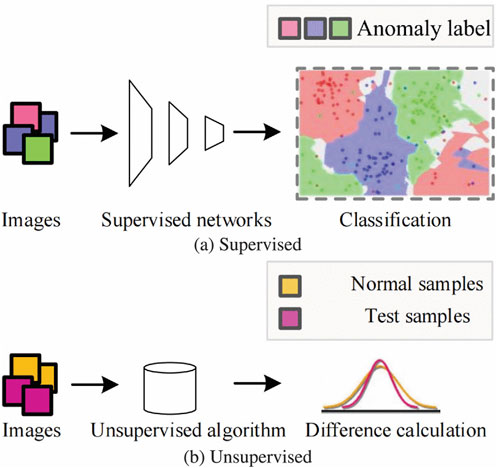
Figure 2. Comparison of Architectural Diagram of supervised represented in (a) and unsupervised algorithms represented in (b).
Automated visual inspection of manufactured parts has significantly benefited from supervised learning techniques (Weiher et al., 2023), variational autoencoder based supervised technique (Kawachi et al., 2018), specifically employing Faster R-CNN methods for smart surface inspection, as referenced in studies Wang Y. et al. (2020) and Bhatt et al. (2021). These advanced techniques have also been effectively utilized in various other applications, including the automatic detection of defects in sewer pipes, as well as in the identification of cracks in masonry walls (Loverdos and Sarhosis, 2022) and defects in steel products (Ibrahim and Tapamo, 2024). By leveraging the capabilities of supervised learning, these applications demonstrate the potential for enhanced accuracy and efficiency in defect detection and quality control processes across different industries (Brasington et al., 2021).
2.1.2 Unsupervised based
Unsupervised Figure 2, visual anomaly detection algorithms have garnered significant attention due to their ability to construct detection models without requiring annotated samples as shown in Lee and Kang (2022), Sun (2024), Tan and Wong (2024), and Zipfel et al. (2023).This characteristic makes them particularly well-suited for various practical applications where the collection of normal images is considerably easier and less costly compared to anomalous images. The primary advantage of these models lies in their capacity to detect a broad spectrum of anomalies by analyzing the deviations from normal samples. This enables the detection of new and unforeseen types of defects, enhancing the robustness and versatility of the detection systems (Pinon et al., 2024; Zhang F. et al., 2023; Kascenas et al., 2022). Reconstruction Based methods rely on the premise that anomalies cannot be effectively reconstructed by models trained only on normal data techniques like autoencoders (Kawachi et al., 2018; Jiang et al., 2023; Jia, 2023) as shown in Figure 3, variational autoencoders(VAEs) (Lu et al., 2024a; Lu et al., 2024b; Wang et al., 2022; Chen T. et al., 2023; Angiulli, 2023; Moon et al., 2023; Maggipinto et al., 2022; Lee and Kang, 2022; Faber et al., 2023; Zhang, 2022; González-Muñiz et al., 2022; Tao et al., 2022; Zhou et al., 2021; Ulger et al., 2021; Marimont and Tarroni, 2021; Wang X. et al., 2020) and generative adversarial networks (GANs) are commonly used (Kim, 2020; Tang et al., 2020; Han et al., 2021; Kolte, 2023; Liu R. et al., 2023; Králik et al., 2024; Ivanovska and Å truc, 2024). The reconstruction error is utilized to distinguish between normal and anomalous samples (Lin, 2023). Normalizing Flow (NF)-based methods use invertible neural networks to model the data distribution of normal samples. By transforming normal data into a simpler distribution (e.g., a standard Gaussian), anomalies can be detected based on the likelihood under the learned distribution (Hirschorn and Avidan, 2023; Gudovskiy et al., 2021).
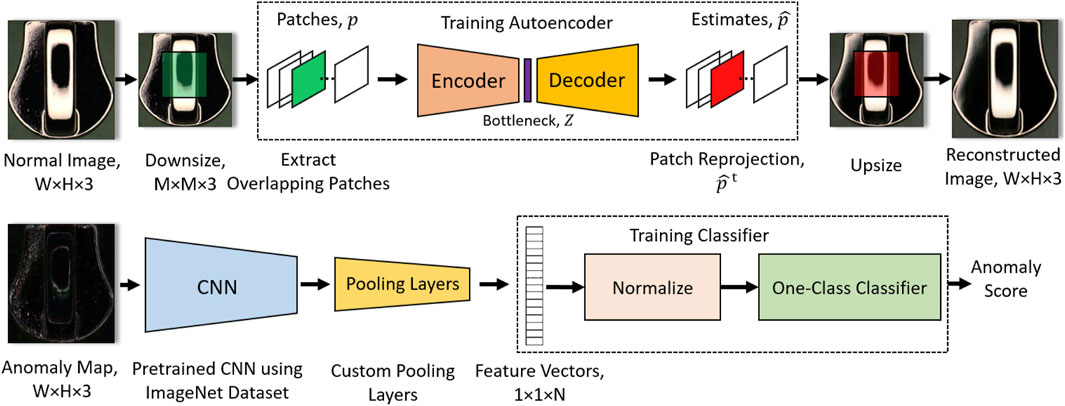
Figure 3. Anomaly detection autoencoder method (reprinted with permission from Saeedi and Giusti, 2023, licensed under CC-BY-NC-ND).
Representation-based methods focus on learning feature representations that effectively capture the essence of normal data. Anomalies are identified by their deviation from these learned representations, methods such as deep metric learning and self-supervised learning fall under this category (Zingman et al., 2024). Data augmentation-based method used by augmenting the normal data with various transformations, these methods enhance the robustness of the detection model techniques like synthetic data generation and adversarial training are used to simulate potential anomalies and improve the model’s ability to detect real anomalies (Oyelade and Ezugwu, 2021; Motamed et al., 2021; Jain, 2022).
2.1.3 Semi- supervised based
The professional process and commonly used methodologies in semi-supervised learning-based anomaly detection for images has been discussed. Semi-supervised visual anomaly detection methods leverage both labeled and unlabeled data to enhance detection performance. By using a small amount of labeled data along with a large pool of unlabeled data, these methods improve accuracy while reducing the need for extensive labeling. Key approaches include self-training, where the model iteratively labels and retrains on unlabeled data, consistency regularization, which ensures stable predictions under data perturbations, graph-based methods, which propagate labels through data similarities and generative models, which enhance detection by improving data generation processes. This hybrid approach effectively balances the benefits of supervised and unsupervised methods, making it suitable for scenarios with limited labeled data (Saheel et al., 2024; Saeedi and Giusti, 2023; Akcay et al., 2018; Rudolph et al., 2020).
An overview of the most recent techniques for detecting image anomalies is provided in Table 4 using denoising diffusion (Li et al., 2024), diffusion model (Xu H. et al., 2023; Hu and Wang, 2023) This comprehensive summary seeks to inform and advance implementation and practice within the industrial field.
3 Popular anomaly detection datasets: data links, performance evaluation, and comparative analysis
We are providing links to a diverse range of popular anomaly detection datasets, encompassing domains such as civil infrastructure with bridge crack image data and crack forest data, as well as material science with concrete crack images, tile surface defects, and steel defects. The links to popular anomaly detection datasets are provided in Table 5.
The discussed Figure 4 provide visual examples of anomalous industrial images. (a) Illustrates examples of anomalous and anomaly-free objects (hazelnut, metal nut) and textures (carpet) from the MVTec Industrial Inspection Anomaly Detection dataset. (b) Showcases various industrial steel surface defects, including patches, crazing, pitted surfaces, scratches, and (c) illustrates the various types of defects found in different materials within the dataset. These include flaws found in photovoltaic cells, magnetic tiles, and fabric. While imperfections in photovoltaic cells may impact energy conversion efficiency, errors in magnetic tiles can jeopardize their structural integrity and magnetic qualities. Similar to this, flaws in fabric may affect its feel, longevity, or visual attractiveness. It is essential to comprehend and classify these flaws in order to maintain quality control and enhance material performances.
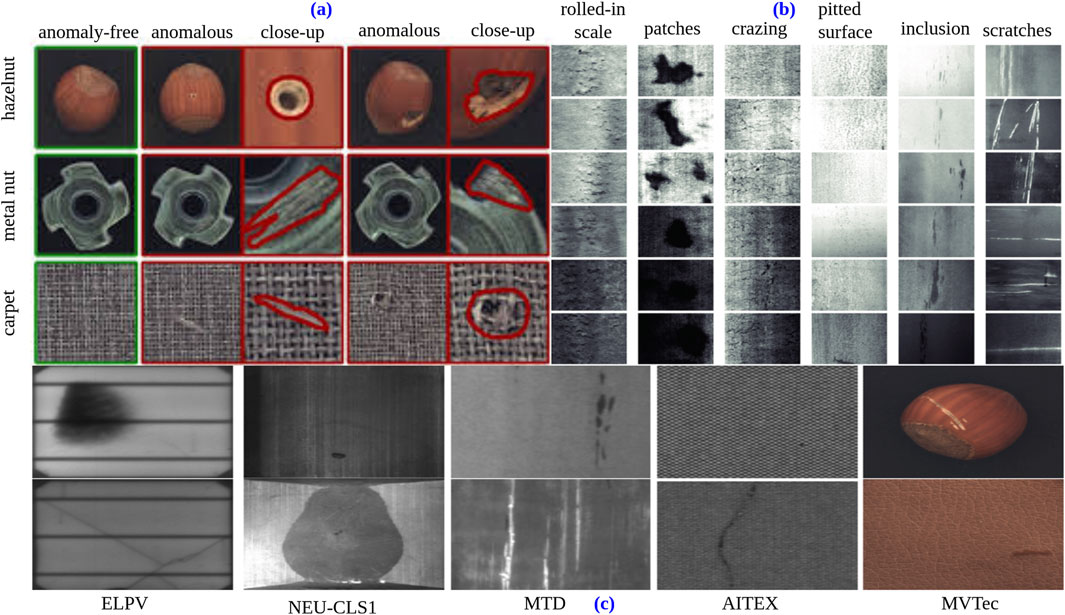
Figure 4. (a) Represents two objects (hazelnut and metal nut) and one texture (carpet) from the MVTec industrial inspection anomaly detection dataset (reproduced with permission from Bergmann et al., 2021, licensed under CC BY), (b) shows the examples of industrial steel surface defect (© 2018 International Federation of Automatic Control. Reproduced with the permission of IFAC from Li et al., 2018) and (c) shows defects of various materials in datasets (reproduced with permission from Cui et al., 2023, licensed under CC-BY-NC-ND). ELPV originally published and reproduced with permission from Deitsch et al. (2019). MTD originally published and reproduced with permission from https://github.com/abin24/Magnetic-tile-defect-datasets. (Huang et al., 2018). AITEX originally published and reproduced with permission from https://www.aitex.es/afid/ (Silvestre-Blanes et al., 2019). MVTec originally published and reproduced with permission from Bergmann et al. (2019) Copyright © 2019, IEEE.
Algorithm Enhancement includes improvements and modifications to existing algorithms to boost their performance. Several methodologies explore innovative techniques to optimize the performance of algorithms, with a specific emphasis on improving metrics such as AUC, as illustrated in Table 6. The model enhancements might involve better loss functions, advanced training techniques, or hybrid approaches that combine multiple methods on different industrial datasets.
4 Industrial application context, challenges and recommendation
Anomaly detection has a wide range of significant industrial manufacturing applications (Xie et al., 2024), for instance Figure 5, highlights the detection of defects in depth images of composite carbon fiber surfaces in Automated Fiber Placement (AFP) industry. This demonstrates the potential of anomaly detection techniques to improve manufacturing efficiency and quality control in real-world maintenance and inspection scenarios. For example, identifying defects in metal welding for oil pipelines, assessing photovoltaic modules in solar power plants, and inspecting wind turbine blades in wind farms. Furthermore, they play a critical role in monitoring components like catenary droppers in overhead catenary systems, electrical insulators, nuts, bolts, and witness marks used in power transmission lines and catenary support devices.

Figure 5. (a) Depicts depth images of composite carbon fiber surfaces, showcasing anomaly detection in the Automated Fiber Placement (AFP) industry (reprinted with permission from Ghamisi et al., 2024, licensed under CC BY 4.0). (b) Presents example images from the MIAD dataset, covering seven maintenance inspection scenarios. The test set for each scenario includes non-defective images (top row) and defective images (bottom row). The first four scenarios focus on surface anomalies, while the remaining three involve logical anomalies. Pixel-precise annotations are provided for all detected anomalies (reprinted with permission from Bao et al., 2023, Copyright © 2023 by The Institute of Electrical and Electronics Engineers, Inc.).
Image-based anomaly detection faces several challenges that need to be addressed for effective and efficient implementation. These challenges include real-time processing, handling small sample sizes and texture differences, detecting small targets, and managing unbalanced sample identification. Figure 6 highlights the data-level challenges in surface defect detection below, we explore these issues and provide recommendations for each.
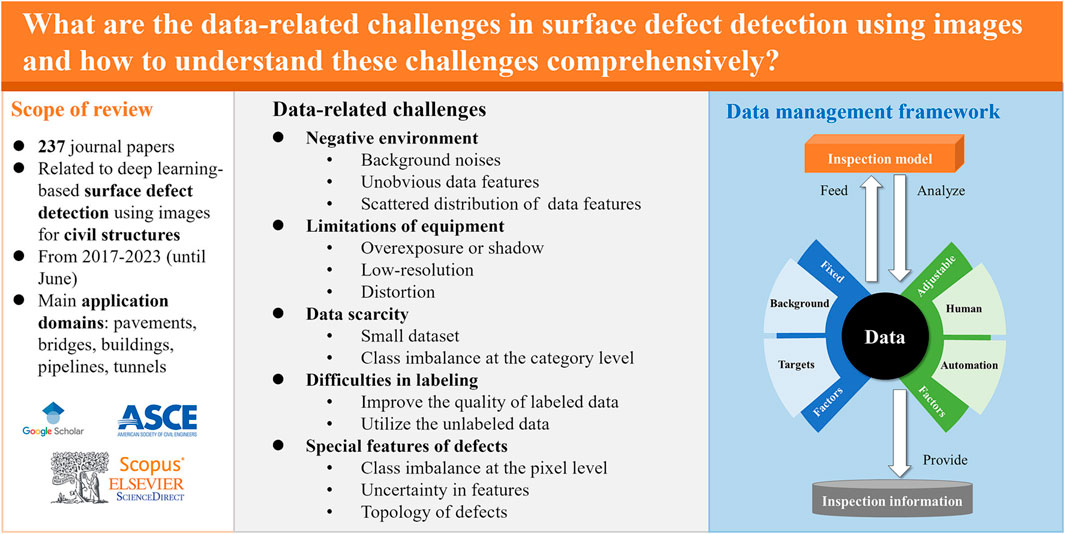
Figure 6. Data level challenge in surface defect detection (reprinted from Guo et al., 2024, Copyright 2023, with permission from Elsevier).
4.1 Real-time problem challenge
Real-time anomaly detection requires rapid processing and analysis of image data, which can be computationally intensive and demanding.
4.1.1 Recommendation
Han and Yan (2023) introduced Collaborative Representation Distance (CRD), an approach designed for practical anomaly detection, demonstrating the importance of optimized computational frameworks to achieve real-time performance.
In addition to hardware acceleration, implementing lightweight models like MobileNet can substantially improve inference speed while maintaining detection accuracy. Feng and Wang (2024) proposed an efficient object tracking algorithm based on lightweight Siamese networks, which highlights the benefits of compact architectures in real-time applications.
Further performance gains can be achieved through pruning and quantization techniques, which reduce model size and computational requirements without significantly degrading accuracy. Liang et al. (2021) provided a comprehensive survey on pruning and quantization for deep neural network acceleration, demonstrating how these techniques enhance model efficiency, particularly in resource-constrained environments.
By integrating efficient network architectures, hardware acceleration, and model compression techniques, real-time anomaly detection systems can achieve faster inference while maintaining high accuracy. These optimizations make real-time anomaly detection feasible for applications in industrial inspection, autonomous systems, and surveillance, where rapid decision-making is crucial.
To address this, optimizing the network structure for efficiency and deploying hardware acceleration techniques such as GPUs or TPUs can significantly improve processing speed (Han and Yan, 2023). Implementing lightweight models like MobileNet or using pruning and quantization techniques can also enhance real-time performance (Liang et al., 2021).
4.2 Small sample problem and texture difference challenge
Limited sample sizes and texture variations pose significant hurdles in accurately detecting anomalies, as models might not generalize well from sparse data.
4.2.1 Combination of data distribution learning and data augmentation recommendation
Leveraging advanced data distribution learning methods and data augmentation techniques can mitigate these issues. By augmenting the existing dataset with synthetic variations (e.g., rotations, flips, color adjustments), the model can be exposed to a broader range of scenarios, enhancing its robustness. Studies have shown that combining these approaches can significantly improve detection accuracy (Fullington et al., 2024; Xu M. et al., 2023).
4.2.2 Transfer learning recommendation
Transfer learning involves using pre-trained models on related tasks and fine-tuning them on the target anomaly detection task. This approach can overcome small sample problems by utilizing the knowledge embedded in models trained on large datasets, thus improving performance on smaller, specific datasets.
Limited sample sizes and texture variations pose significant hurdles in accurately detecting anomalies, as models might struggle to generalize from sparse data. When trained on small datasets, deep learning models often suffer from overfitting, leading to poor performance in real-world applications.
To address this challenge, transfer learning has emerged as a powerful technique. By leveraging knowledge embedded in models pre-trained on large-scale datasets, transfer learning enables effective feature extraction, improving performance on smaller, domain-specific datasets (Chen et al., 2023b). demonstrated its effectiveness in multimode process monitoring and anomaly detection for steam turbines, showing that adaptive transfer learning enhances model generalization across different operating conditions.
Similarly, Liu et al. (2023d) introduced SimpleNet, an efficient network designed for image anomaly detection and localization, utilizing transfer learning to mitigate the impact of limited training samples. Maray et al. (2023) further validated this approach in healthcare applications, showing that transfer learning significantly improves fall detection accuracy even with small datasets.
Iman et al. (2023) provided a comprehensive review of deep transfer learning, highlighting recent advancements and techniques that enhance model adaptability to new domains. Zhao et al. (2024) extended this concept to industrial applications, employing contrastive and transfer learning-based methods for small component inspection in assembly lines, demonstrating that prior knowledge can aid in detecting fine-grained defects.
In manufacturing, Shin (2024) introduced a material-adaptive anomaly detection framework, where property-concatenated transfer learning proved beneficial in wire arc additive manufacturing. Similarly, Cheng et al. (2022) applied transfer learning to defect detection in fabrics using a specialized U-Net architecture, improving segmentation accuracy with limited annotated data.
Medical applications have also benefited significantly from transfer learning. Lanjewar et al. (2024) fused transfer learning models with LSTMs to enhance breast cancer detection using ultrasound images, while Ani et al. (2024) explored multi-class classification of breast cancer abnormalities, proving the effectiveness of transfer learning in medical imaging scenarios.
By leveraging pre-trained models and adapting them to specific anomaly detection tasks, transfer learning provides a robust solution to the challenges posed by limited sample sizes and texture variations. It enables models to generalize better, reducing the need for extensive labeled data while maintaining high detection accuracy.
4.2.3 Optimize network structure recommendation
Optimizing the network architecture to suit the specific characteristics of the anomaly detection task is crucial for improving performance. A well-structured model can better capture the nuances of small sample data and texture variations, ensuring robust detection across different scenarios.
One approach to achieving this is Neural Architecture Search (NAS), which automates the design of optimal network structures by exploring various architectures to find the most efficient model for a given anomaly detection task. Alternatively, manually designing lightweight yet effective models can also lead to significant improvements by tailoring architectures to specific dataset constraints.
Cao Y. et al. (2023) introduced a Collaborative Discrepancy Optimization framework for reliable image anomaly localization, demonstrating that optimizing network structures can enhance detection accuracy and robustness. Their approach highlights the importance of fine-tuning architectures to maximize sensitivity to abnormal patterns while maintaining computational efficiency.
Wan et al. (2024) further advanced this idea by integrating Singular Spectrum Analysis (SSA) with an optimized ResNet50-BiGRU model for image anomaly detection and prediction. Their work shows that fusing convolutional networks (ResNet50) with recurrent architectures (BiGRU) can effectively capture spatial and sequential anomaly patterns, making the detection process more precise and adaptive.
By leveraging structured network optimization techniques, either through NAS or manual model refinement, anomaly detection systems can achieve higher accuracy while remaining lightweight. This is particularly beneficial for real-time and resource-constrained applications, where both computational efficiency and detection reliability are essential.
4.3 Small target detection problem challenge
Detecting small anomalies or targets within images is challenging due to their minimal pixel footprint, making them difficult to distinguish from noise. Detecting small targets in images presents significant challenges due to low resolution, background noise, and scale variations. Small objects often lack distinguishable features, making it difficult for deep learning models to differentiate them from their surroundings.
4.3.1 Recommendation
To address this, enhancing image resolution, leveraging multi-scale feature extraction techniques, and implementing attention mechanisms can significantly improve detection accuracy.
Multi-scale feature extraction allows models to capture fine details across different resolutions. Feature Pyramid Networks (FPN) and YOLO (You Only Look Once) are widely used architectures that enhance small target detection by leveraging hierarchical feature maps. Additionally, attention mechanisms improve focus on relevant features while suppressing background noise, thereby enhancing detection reliability. Chen et al. (2021) introduced MAMA-Net (Multi-Scale Attention Memory Autoencoder Network) for anomaly detection, demonstrating that combining attention with multi-scale memory networks enhances small target recognition in medical imaging. Their approach highlights the benefits of multi-scale learning for capturing subtle anomalies.
Xiang et al. (2023) extended this concept by proposing a Multi-Scale Attention and Dilation Network for small defect detection. By integrating dilated convolutions with attention mechanisms, their model effectively extracts fine-grained features, improving defect localization on industrial surfaces.
Xiao et al. (2022) developed a feature fusion-enhanced multiscale CNN with an attention mechanism for spot-welding surface appearance recognition. Their work demonstrated that fusing multi-resolution features allows the network to better differentiate between normal and defective welds.
Yang et al. (2020) further improved unsupervised anomaly localization by incorporating multi-scale memory modules into autoencoders, enhancing the model’s ability to detect small deviations in structured environments.
More recently, Tao et al. (2024) introduced a method for learning multi-resolution features for unsupervised anomaly localization on industrial textured surfaces. Their approach leverages multi-scale representations to detect subtle texture differences, significantly improving performance in real-world manufacturing applications.
By integrating multi-scale feature extraction, attention mechanisms, and resolution-enhancing techniques, small target detection models can achieve higher precision, making them applicable to areas such as medical imaging, industrial inspection, and remote sensing. These advancements ensure that even the smallest anomalies or defects are accurately identified, improving overall system reliability.
4.4 Data level challenges
Imbalanced datasets, where normal samples significantly outnumber anomalous ones, can bias the model towards the majority class, reducing the effectiveness of anomaly detection. A variety of datasets have been used to explore the challenges inherent in Industrial Anomaly Detection.
4.4.1 Recommendation
Table 7 Provides a detailed overview of these datasets and their specific characteristics. Addressing this issue at the data level can involve techniques such as oversampling the minority class (anomalies) or undersampling the majority class (normal samples). Additionally, synthetic data generation methods, such as using GANs (Generative Adversarial Networks) to create realistic anomalous samples, can help balance the dataset. Implementing these strategies ensures that the model receives sufficient training on anomalies, improving its detection capabilities.

Table 7. Challenges in AD: Different datasets illustrate the challenges in the IAD field (Acronym Y: Yes).
Zeiser et al. (2023) provided a detailed evaluation of deep unsupervised anomaly detection methods, emphasizing a data-centric approach for online inspection. Their work highlights how dataset characteristics significantly impact model performance, reinforcing the need for effective data-balancing techniques.
Yang Y. et al. (2023) proposed a deep learning-based anomaly detection approach that extracts representative latent features to handle cases where anomalies are low-discriminative or insufficient in quantity. Their method improves anomaly detection by enhancing feature extraction from limited abnormal data.
Mun et al. (2024) tackled data imbalance in AI-driven Clinical Decision Support Systems (AI-CDSS) by introducing U-AnoGAN, a GAN-based anomaly detection framework. Their study demonstrated that synthetically generated anomalies can significantly enhance model robustness, especially in medical applications where real abnormal samples are scarce.
Liu D. et al. (2023) introduced Deep Attention SMOTE, a data augmentation method that uses a learnable interpolation factor to generate synthetic samples for imbalanced anomaly detection in gas turbines. This approach improves detection capabilities by creating diverse training samples that prevent model bias toward the majority class.
Beyond simple resampling techniques, Cao T. et al. (2023) explored anomaly detection under distribution shift, addressing the challenge where real-world data distributions differ from those seen during training. Their findings suggest that models trained on balanced datasets must also be adaptable to dynamic, evolving data distributions to maintain high anomaly detection accuracy.
By integrating oversampling, undersampling, synthetic data generation, and distribution-aware anomaly detection methods, data-level challenges in anomaly detection can be effectively mitigated. These techniques enhance model robustness, improve generalization on rare anomalies, and ensure better real-world applicability across diverse domains, including industrial inspection, medical diagnostics, and predictive maintenance.
4.5 UAV based anomaly detection applications
Unmanned Aerial Vehicle (UAV)-based anomaly detection is advancing real-time monitoring across various fields by leveraging deep learning as shown in Figure 7, a drone-based anomaly detection pipeline. Unmanned Sensing Vehicles (USVs), including UAVs, are used in environmental monitoring (Gupta, 2022; Pandya et al., 2024; Roos-Hoefgeest et al., 2023). A vision-based approach for UAVs is proposed for tracking and inspecting industrial pipelines. This system focuses on oil and gas refineries, where long pipelines at high altitudes pose challenges to human safety and operational costs. The UAV autonomously navigates the pipeline’s centerline using a depth sensor to generate control data and detect defects. Simulated and real experiments in GPS-denied environments validate the system’s effectiveness. Figure. 8 highlights anomalies detected during pipeline inspections in industrial contexts. Demonstrated inspection of vertical and horizontal structures for structural health monitoring and defect detection using UAV in contact and non-contact methods.
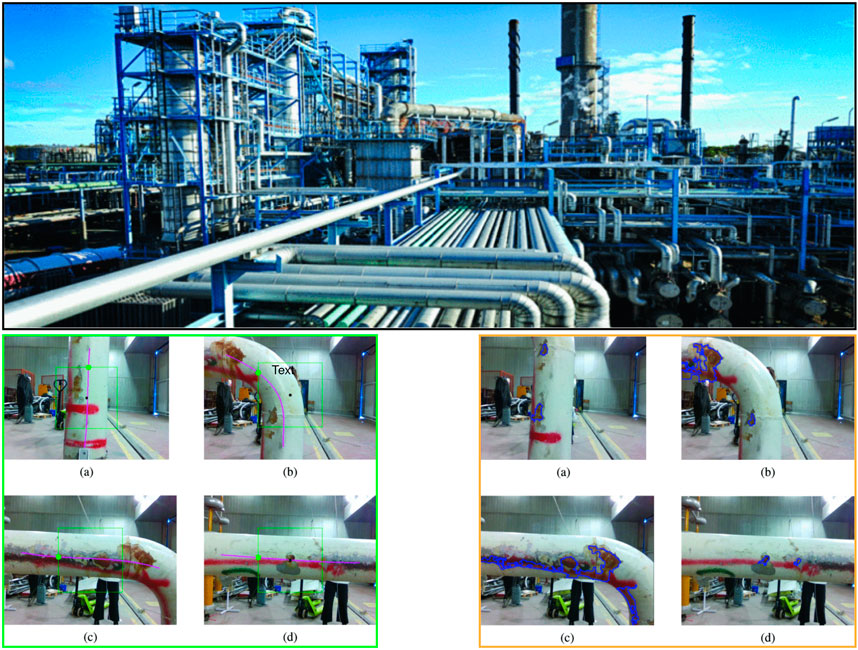
Figure 8. Industrial pipeline anomaly detection (reprinted with permission from Roos-Hoefgeest et al., 2023 Copyright © 2023, IEEE). (a–d, green border) Pipeline tracking: pink line marks the central axis, green guides the drone. (a–d, orange border) Corrosion detection on RGB pipeline images, defects in blue.
Precision agriculture is one main field, apart from industries, where image-based anomaly detection can be extended to simplify complex traditional methods (Subramanian et al., 2021; Mendoza-Bernal et al., 2024). Used UAVs equipped with IR camera for collecting thermal imagery from agriculture fields. Further analyzed leaf health and field water distributions from recognizing pattern from thermal imagery and CNNs. A novel adaptive sampling strategy for USVs uses spatio-temporal sequential tensor decomposition to optimize deployment for effective change detection.
For photovoltaic (PV) plant maintenance, UAVs with thermal imagers detect module defects using infrared (IR) and RGB images. The system employs SIFT for feature detection and CNNs for defect classification, achieving high accuracy and supporting real-time detection, significantly aiding PV plant maintenance (Jeffrey Kuo et al., 2023).
In traffic surveillance, UAVs address the challenges of rare events and complex backgrounds. A transformer-based future frame prediction network detects anomalies in drone videography by capturing spatial and temporal representations, demonstrating superior performance on datasets like UIT-ADrone and Drone-Anomaly (Tran et al., 2024).
These developments highlight the effectiveness of UAV-based anomaly detection systems, leveraging deep learning to enhance real-time monitoring and operational efficiency across various applications. Figure 9 explores emerging trends and opportunities in industrial applications, highlighting potential future developments. While UAVs are the best platform for outdoor and high-roof industrial inspections, AGVs (Autonomous Ground Vehicles) and robotic arms (manipulators) are best suited for indoor and assembly line inspections.
4.6 AGV and manipulator based anomaly detection applications
AGVs and robotic arms are well-suited for inspection tasks in cluttered factory and assembly line environments due to their mobility (Pérez et al., 2016). Highlights the significance of 3D vision systems in enhancing the capabilities of robotic arms for tasks such as navigation, object detection, and precise positioning. By carefully selecting appropriate vision techniques, like laser range finders or stereo imaging, based on specific task requirements and factory environments, robotic arms can be better adapted to real-world industrial settings. This enables collaborative tasks and real-time decision-making, ultimately improving overall operational efficiency. Manipulator mounted with high resolution multi-view camera can collect the images of industrial components from different views to inspect them (Galdelli et al., 2019). Khan et al. (2021) presented an automated vision-based ultrasonic Non-Destructive Testing (NDT) inspection system for manufacturing industries. To improve inspection efficiency, a practical method for accurate 3D reconstruction is proposed. Structure from Motion (SfM) techniques are utilized to generate precise 3D models of objects of interest with sub-millimeter accuracy. The paraboloid spiral tool path by robot arm has demonstrated the best accuracy of 0.43 mm (Ali et al., 2018; Surya Prakash et al., 2024a; Surya Prakash et al., 2024b). The factory setup comprises industrial components and a globally fixed camera to observe objects. The proposed methodology employs a hybrid approach that integrates classical vision techniques with deep learning algorithms. This hybrid approach enables the detection and size estimation of industrial components, facilitating subsequent actions by a 6-DOF manipulator. Inspection of objects in hazardous environments, such as high-temperature or toxic gas areas, necessitates the use of robotic manipulators controlled remotely through teleoperation. This approach provides visual and haptic feedback to operators, enabling them to safely perform intricate tasks in these challenging conditions (Naceri et al., 2019). For spacious environments, such as warehouses or large manufacturing facilities, Autonomous Guided Vehicles (AGVs) equipped with sensors are an ideal choice. Their mobility allows them to navigate complex and cluttered factory layouts efficiently. Sanchez-Cubillo et al. (2024) investigated the application of deep learning techniques to enhance the performance of Autonomous Mobile Robots (AMRs) and Autonomous Guided Vehicles (AGVs) in wide-area inspections, such as railway track and wagon loading/unloading inspections. Bao et al. (2022) presents a computer vision-based mobile robot system for inspection and maintenance of industrial pipe work, mainly focusing on colorless objects like water which are difficult to detect in cluttered environments. System leverages the reflective properties of lower temperature effusion relative to their surroundings, using dual source imaging and contour feature algorithm.
Further combinations of AGVs and robotic arms can be explored for inspection and taking appropriate actions to resolve anomalies or tag them by highlighting the defective area. Researchers can focus their efforts on factory inspections.
5 Conclusion and future directions
This review paper discusses the use of deep learning techniques for detecting image anomalies. It compares traditional methods with advanced deep learning approaches, including supervised, unsupervised, and semi-supervised paradigms, and addresses challenges such as real-time processing and sample imbalance, providing strategies for mitigation.
The paper surveys existing algorithms, examines different learning paradigms, and analyzes various anomaly detection methods. It highlights popular datasets, evaluation metrics, and evaluates current methods across diverse datasets, with a focus on deep learning applications in UAV,AGV,robotic manipulator-based anomaly detection. Additionally, it suggests future directions for overcoming current challenges.
Key industrial applications include few-shot anomaly detection to reduce data collection costs, enhancing robustness against labeling errors, utilizing spatial information for 3D anomaly detection, and improving model performance through synthetic data generation.
The review introduces several anomalies in different data applications like MVTec AD, Severstal Steel Defect, and Magnetic Tile Surface Defects, yarn-dyed fabric defect detection and discusses challenges such as real-time processing, small sample sizes, texture differences, small target detection, data limitation, and unbalanced sample identification. Proposed solutions include optimizing network structures, data augmentation, transfer learning, enhancing image resolution, and synthetic data generation.
In summary, this review systematically explores defect detection methodologies, aiming to help researchers and industry stakeholders enhance quality assurance in manufacturing through advanced image anomaly detection techniques.
5.1 Anomaly detection based future project directions
1. Crack Detection in Railway Tracks - Using drone-based image processing to identify cracks and fractures in railway tracks to help prevent accidents.
2. Surface Defect Detection in Manufacturing - Automatically detecting scratches, dents, and misalignments in industrial components to ensure quality control.
3. Underwater Crack Detection in Dams and Pipelines - Monitoring the structural integrity of underwater infrastructure using AI-powered autonomous underwater vehicles (AUVs).
4. Anomaly Detection in PCB (Printed Circuit Board) Inspection - Identifying missing components, soldering defects, and misaligned circuits in printed circuit boards.
5. Predictive Maintenance in Industrial Machinery Using Thermal/Visual Imaging - Detecting wear and tear in rotating machinery through deep learning analysis of infrared and RGB images.
6. Surface Corrosion and Rust Detection on Metal Structures - Identifying early signs of corrosion and rust on bridges, pipelines, and marine structures.
7. Food Quality Inspection in Factories - Using AI-based visual inspection to detect contamination, bruises, and deformities in food products.
8. X-ray and CT Image Anomaly Detection for Cargo and Security - Identifying concealed weapons, drugs, and smuggled items in security scans using advanced imaging techniques.
9. Optical Inspection for Textiles and Fabric Defect Detection - Detecting weaving defects, misprints, and other irregularities in textile manufacturing.
10. AI-Powered Glass Surface Defect Detection - Identifying scratches, cracks, and contamination on glass surfaces used in construction and electronics.
11. Leakage Detection in Oil and Gas Pipelines - Using thermal and hyperspectral imaging to detect small leaks in oil and gas pipelines.
12. Automated Inspection of Weld Defects - Identifying cracks, porosity, and misalignment in welds using deep learning algorithms.
13. Battery Cell Anomaly Detection in EV Manufacturing - Detecting defects in lithium-ion battery cells using thermal imaging technology.
14. Structural Health Monitoring of Bridges and Highways - Using UAV-based vision systems to identify structural anomalies and cracks in large-scale infrastructure like bridges and highways.
15. Automated Defect Inspection in Aerospace Components - Detecting defects in aerospace components to ensure safety and reliability in the aviation industry
Further research is needed on foundational models, which, as pre-trained models, show great potential in anomaly detection due to their ability to capture broad patterns and quickly adapt to new domains with high-quality representation. Their application in industrial anomaly detection is promising but still requires further exploration.
Author contributions
VS: Conceptualization, Data curation, Formal Analysis, Investigation, Methodology, Writing – original draft, Writing – review and editing. AS: Supervision, Validation, Writing – review and editing. SSK: Formal Analysis, Validation, Writing – review and editing. SS: Visualization, Writing – review and editing.
Funding
The author(s) declare that no financial support was received for the research and/or publication of this article.
Conflict of interest
The authors declare that the research was conducted in the absence of any commercial or financial relationships that could be construed as a potential conflict of interest.
Generative AI statement
The author(s) declare that Generative AI was used in the creation of this manuscript. The authors acknowledge the use of generative AI in the preparation of this manuscript. Specifically: Figure 9 (“Future-Forward Industrial Applications”) was created using generative AI visualization tools. Google Gemini was utilized for English language refinement, including: Grammar checking, Punctuation optimization, Sentence structure improvements. All AI-generated content was thoroughly reviewed and verified by the authors, who take full responsibility for its accuracy and appropriateness within the manuscript’s context.
Publisher’s note
All claims expressed in this article are solely those of the authors and do not necessarily represent those of their affiliated organizations, or those of the publisher, the editors and the reviewers. Any product that may be evaluated in this article, or claim that may be made by its manufacturer, is not guaranteed or endorsed by the publisher.
References
Akcay, S., Atapour-Abarghouei, A., and Breckon, T. P. (2018). Ganomaly: semi-supervised anomaly detection via adversarial training. CoRR abs/1805.06725. Available online at: http://arxiv.org/abs/1805.06725
Akcay, A.-A. A. B. T. S., Atapour-Abarghouei, A., and Breckon, T. P. (2019). Ganomaly: semi-supervised anomaly detection via adversarial training. Lecture Notes Comput. Sci. 11363, 622–637. doi:10.1007/978-3-030-20893-6_39
Ali, M. H. K., A, K. Y. T. Z., and O, A. (2018). Vision-based robot manipulator for industrial applications. Procedia Comput. Sci. 133, 205–212. doi:10.1016/j.procs.2018.07.025
Andrews, J. T. A., Tanay, T., Morton, E. J., and Griffin, L. D. (2016). “Transfer representation-learning for anomaly detection,” in International conference on machine learning.
Angiulli, F. F. F. L. F., Fassetti, F., and Ferragina, L. (2023). Latent Out: an unsupervised deep anomaly detection approach exploiting latent space distribution. Mach. Learn 112, 4323–4349. doi:10.1007/s10994-022-06153-4
Ani, G. D. S. S. R. N., Gupta, D. K., and Singh, S. (2024). Multi-class classification of breast cancer abnormality using transfer learning. Multimed. Tools Appl. 83, 75085–75100. doi:10.1007/s11042-023-17832-2
Bai, D., Li, G., Jiang, D., Yun, J., Tao, B., Jiang, G., et al. (2024). Surface defect detection methods for industrial products with imbalanced samples: a review of progress in the 2020s. Eng. Appl. Artif. Intell. 130, 107697. doi:10.1016/j.engappai.2023.107697
Bansod, N. A. S. D., and Nandedkar, A. V. (2020). Crowd anomaly detection and localization using histogram of magnitude and momentum. Vis. Comput. 36, 609–620. doi:10.1007/s00371-019-01647-0
Bao, N., Fan, Y., Ye, Z., and Simeone, A. (2022). A machine vision–based pipe leakage detection system for automated power plant maintenance. Sensors 22, 1588. doi:10.3390/s22041588
Bao, T., Chen, J., Li, W., Wang, X., Fei, J., Wu, L., et al. (2023). “Miad: a maintenance inspection dataset for unsupervised anomaly detection,” in Proceedings of the IEEE/CVF international conference on computer vision, 993–1002. doi:10.1109/ICCVW60793.2023.00106
Behrendt, F., Bhattacharya, D., Maack, L., Krüger, J., Opfer, R., Mieling, R., et al. (2024). Diffusion models with ensembled structure-based anomaly scoring for unsupervised anomaly detection. arXiv, 1–4. doi:10.1109/isbi56570.2024.10635828
Bergmann, P., Fauser, M., Sattlegger, D., and Steger, C. (2019). “Mvtec ad – a comprehensive real-world dataset for unsupervised anomaly detection,” in 2019 IEEE/CVF conference on computer vision and pattern recognition (CVPR), 9584–9592. doi:10.1109/CVPR.2019.00982
Bergmann, P., Fauser, M., Sattlegger, D., and Steger, C. (2020). “Uninformed students: student-teacher anomaly detection with discriminative latent embeddings,” in 2020 IEEE/CVF conference on computer vision and pattern recognition (CVPR) (IEEE). doi:10.1109/cvpr42600.2020.00424
Bergmann, P., Batzner, K., Fauser, M., Sattlegger, D., and Steger, C. (2021). The mvtec anomaly detection dataset: a comprehensive real-world dataset for unsupervised anomaly detection. Int. J. Comput. Vis. 129, 1038–1059. doi:10.1007/s11263-020-01400-4
Bhandarkar, V., Shahare, H., Mall, A., and Tandon, P. (2024). An overview of traditional and advanced methods to detect part defects in additive manufacturing processes. J. Intelligent Manuf, 1–36. doi:10.1007/s10845-024-02483-3
Bhatt, P. M., Malhan, R. K., Rajendran, P., Shah, B. C., Thakar, S., Yoon, Y. J., et al. (2021). Image-based surface defect detection using deep learning: a review. J. Comput. Inf. Sci. Eng. 21, 040801. doi:10.1115/1.4049535
Brabec, C. J., Camus, C., Hauch, J. A., Doll, B., Berger, S., Gallwitz, F., et al. (2018). A benchmark for visual identification of defective solar cells in electroluminescence imagery. Systems and Soft Computing, 200048.
Brasington, A., Sacco, C., Halbritter, J., Wehbe, R., and Harik, R. (2021). Automated fiber placement: a review of history, current technologies, and future paths forward. Compos. Part C. Open Access 6, 100182. doi:10.1016/j.jcomc.2021.100182
Cao, T., Zhu, J., and Pang, G. (2023a). Anomaly detection under distribution shift. arXiv. 6488–6500. doi:10.1109/iccv51070.2023.00599
Cao, Y., Xu, X., Liu, Z., and Shen, W. (2023b). Collaborative discrepancy optimization for reliable image anomaly localization. IEEE Trans. Industrial Inf. 19, 10674–10683. doi:10.1109/TII.2023.3241579
Carrara, F., Amato, G., Brombin, L., Falchi, F., and Gennaro, C. (2021). “Combining gans and autoencoders for efficient anomaly detection,” in 2020 25th international conference on pattern recognition (ICPR), 3939–3946. doi:10.1109/ICPR48806.2021.9412253
Chakraborty, N., Hasan, A., Liu, S., Ji, T., Liang, W., McPherson, D. L., et al. (2023). Structural attention-based recurrent variational autoencoder for highway vehicle anomaly detection
Chen, Y., Zhang, H., Wang, Y., Yang, Y., Zhou, X., and Wu, Q. M. J. (2021). Mama net: multi-scale attention memory autoencoder network for anomaly detection. IEEE Trans. Med. Imaging 40, 1032–1041. doi:10.1109/TMI.2020.3045295
Chen, T., Li, B., and Zeng, J. (2023a). Learning traces by yourself: blind image forgery localization via anomaly detection with vit-vae. IEEE Signal Process. Lett. 30, 150–154. doi:10.1109/LSP.2023.3245947
Chen, Z., Zhou, D., Zio, E., Xia, T., and Pan, E. (2023b). Adaptive transfer learning for multimode process monitoring and unsupervised anomaly detection in steam turbines. Reliab. Eng. and Syst. Saf. 234, 109162. doi:10.1016/j.ress.2023.109162
Cheng, L., Yi, J., Chen, A., and Zhang, Y. (2022). Fabric defect detection based on separate convolutional unet. Multimed. Tools Appl. 82, 3101–3122. doi:10.1007/s11042-022-13568-7
Cheng, Y. J. C. A. e. a. L., Yi, J., Chen, A., and Zhang, Y. (2023). Fabric defect detection based on separate convolutional unet. Multimed. Tools Appl. 82, 3101–3122. doi:10.1007/s11042-022-13568-7
Cohen, M. J., and Avidan, S. (2022). Transformaly – two (feature spaces) are better than one. CoRR abs/2112.04185. Available online at: https://arxiv.org/abs/2112.04185
Cui, Y., Liu, Z., and Lian, S. (2023). A survey on unsupervised anomaly detection algorithms for industrial images. IEEE Access 11, 55297–55315. doi:10.1109/access.2023.3282993
Cumbajin, E., Rodrigues, N., Costa, P., Miragaia, R., Frazão, L., Costa, N., et al. (2023). A systematic review on deep learning with cnns applied to surface defect detection. J. Imaging 9, 193. doi:10.3390/jimaging9100193
Czimmermann, T., Ciuti, G., Milazzo, M., Chiurazzi, M., Roccella, S., Oddo, C. M., et al. (2020). Visual-based defect detection and classification approaches for industrial applications–a survey. Sensors 20, 1459. doi:10.3390/s20051459
Deitsch, S., Christlein, V., Berger, S., Buerhop-Lutz, C., Maier, A., Gallwitz, F., et al. (2019). Automatic classification of defective photovoltaic module cells in electroluminescence images. Sol. Energy 185, 455–468. doi:10.1016/j.solener.2019.02.067
Ding, C., Pang, G., and Shen, C. (2022). Catching both gray and black swans: open-set supervised anomaly detection. arXiv, 7378–7388. doi:10.1109/cvpr52688.2022.00724
Dorafshan, S., and Maguire, M. (2017). Autonomous detection of concrete cracks on bridge decks and fatigue cracks on steel members.
Dorafshan, S., Maguire, S., and Qi, X. (2016). Automatic surface crack detection in concrete structures using otsu thresholding and morphological operations. doi:10.13140/RG.2.2.34024.47363
Dorafshan, S., Thomas, R. J., Coopmans, C., and Maguire, M. (2018). “Deep learning neural networks for suas-assisted structural inspections: feasibility and application,” in 2018 international conference on unmanned aircraft systems (ICUAS), 874–882. doi:10.1109/ICUAS.2018.8453409
Faber, K., Corizzo, R., Sniezynski, B., and Japkowicz, N. (2023). Vlad: task-agnostic vae-based lifelong anomaly detection. Neural Netw. 165, 248–273. doi:10.1016/j.neunet.2023.05.032
Feng, Z., and Wang, H. (2024). Efficient object tracking algorithm based on lightweight siamese networks. Eng. Appl. Artif. Intell. 133, 107976. doi:10.1016/j.engappai.2024.107976
Fullington, D., Yangue, E., Bappy, M. M., Liu, C., and Tian, W. (2024). Leveraging small-scale datasets for additive manufacturing process modeling and part certification: current practice and remaining gaps. J. Manuf. Syst. 75, 306–321. doi:10.1016/j.jmsy.2024.04.021
Galdelli, A., Pagnotta, D. P., Mancini, A., Freddi, A., Monteriù, A., and Frontoni, E. (2019). “Empowered optical inspection by using robotic manipulator in industrial applications,” in 2019 IEEE/RSJ international conference on intelligent robots and systems (IROS), 2006–2013. doi:10.1109/IROS40897.2019.8968473
Gao, Y., Gao, L., and Li, X. (2023). A hierarchical training-convolutional neural network with feature alignment for steel surface defect recognition. Robotics Computer-Integrated Manuf. 81, 102507. doi:10.1016/j.rcim.2022.102507
Getachew Shiferaw, T., and Yao, L. (2024). Autoencoder-based unsupervised surface defect detection using two-stage training. J. Imaging 10, 111. doi:10.3390/jimaging10050111
Ghamisi, A., Charter, T., Ji, L., Rivard, M., Lund, G., and Najjaran, H. (2024). Anomaly detection in automated fibre placement: learning with data limitations. Front. Manuf. Technol. 4, 1277152. doi:10.3389/fmtec.2024.1277152
González-Muñiz, A., Díaz, I., Cuadrado, A. A., García-Pérez, D., and Pérez, D. (2022). Two-step residual-error based approach for anomaly detection in engineering systems using variational autoencoders. Comput. Electr. Eng. 101, 108065. doi:10.1016/j.compeleceng.2022.108065
Grishin, A., Boris, V., iBardintsev, , inversion, , and Oleg, (2019). Severstal: steel defect detection. Kaggle. Available online at: https://kaggle.com/competitions/severstal-steel-defect-detection.
Gudovskiy, D., Ishizaka, S., and Kozuka, K. (2021). CFLOW-AD: real-time unsupervised anomaly detection with localization via conditional normalizing flows. CoRR abs/2107.12571. Available online at: https://arxiv.org/abs/2107.12571
Guo, J., Liu, P., Xiao, B., Deng, L., and Wang, Q. (2024). Surface defect detection of civil structures using images: review from data perspective. Automation Constr. 158, 105186. doi:10.1016/j.autcon.2023.105186
Gupta, S. A. K. A. S. A. A., Shukla, A., Kumar, A., and Shivratri, A. K. (2022). Vision-based autonomous inspection of vertical structures using unmanned aerial vehicle (uav). Am. Soc. Mech. Struct. doi:10.1115/IMECE2022-95698
Han, C., and Yan, Y. (2023). CRD: collaborative representation distance for practical anomaly detection. arXiv preprint. arXiv:2401.09443.
Han, X., Chen, X., and Liu, L.-P. (2021). Gan ensemble for anomaly detection. Proc. AAAI Conf. Artif. Intell. 35, 4090–4097. doi:10.1609/aaai.v35i5.16530
Hirschorn, O., and Avidan, S. (2023). “Normalizing flows for human pose anomaly detection,” in Proceedings of the IEEE/CVF international conference on computer vision (ICCV), 13545–13554.
Hu, B., and Wang, J. (2023). “A feature defusion network for surface anomaly detection of industrial products,” in 2023 5th international conference on intelligent control, measurement and signal processing (ICMSP), 102–106. doi:10.1109/ICMSP58539.2023.10170994
Huang, Y., Qiu, C., Guo, Y., Wang, X., and Yuan, K. (2018). “Surface defect saliency of magnetic tile,” in 2018 IEEE 14th international conference on automation science and engineering (CASE), 612–617. doi:10.1109/COASE.2018.8560423
Ibrahim, A. A. M. S., and Tapamo, J.-R. (2024). A survey of vision-based methods for surface defects’detection and classification in steel products. Informatics 11, 25. doi:10.3390/informatics11020025
Iman, M., Arabnia, H. R., and Rasheed, K. (2023). A review of deep transfer learning and recent advancements. Technologies 11, 40. doi:10.3390/technologies11020040
Ishida, K., Takena, Y., Nota, Y., Mochizuki, R., Matsumura, I., and Ohashi, G. (2023). Sa-patchcore: anomaly detection in dataset with co-occurrence relationships using self-attention. IEEE Access 11, 3232–3240. doi:10.1109/ACCESS.2023.3234745
Ivanovska, M., and Å truc, V. (2024). Y-gan: learning dual data representations for anomaly detection in images. Expert Syst. Appl. 248, 123410. doi:10.1016/j.eswa.2024.123410
Jain, S. G. P. A. E. A. S., Seth, G., Paruthi, A., Soni, U., and Kumar, G. (2022). Synthetic data augmentation for surface defect detection and classification using deep learning. J. Intell. Manuf. 33, 1007–1020. doi:10.1007/s10845-020-01710-x
Jeffrey Kuo, C.-F., Chen, S.-H., and Huang, C.-Y. (2023). Automatic detection, classification and localization of defects inlargephotovoltaic plants using unmanned aerial vehicles (uav) based infrared (ir) and rgb imaging. Energy Convers. Manag. 276, 116495. doi:10.1016/j.enconman.2022.116495
Jha, S. B., and Babiceanu, R. F. (2023). Deep cnn-based visual defect detection: survey of current literature. Comput. Industry 148, 103911. doi:10.1016/j.compind.2023.103911
Jia, H. L. W., and Liu, W. (2023). Anomaly detection in images with shared autoencoders. Front. Neurorobotics 16. doi:10.3389/fnbot.2022.1046867
Jiang, R., Xue, Y., and Zou, D. (2023). Interpretability-aware industrial anomaly detection using autoencoders. IEEE Access 11, 60490–60500. doi:10.1109/ACCESS.2023.3286548
Kascenas, A., Pugeault, N., and O’Neil, A. Q. (2022). “Denoising autoencoders for unsupervised anomaly detection in brain mri,” in Proceedings of the 5th international conference on medical imaging with deep learning Editors E. Konukoglu, B. Menze, A. Venkataraman, C. Baumgartner, Q. Dou, and S. Albarqouni, 653–664.
Kawachi, Y., Koizumi, Y., and Harada, N. (2018). “Complementary set variational autoencoder for supervised anomaly detection,” in 2018 IEEE international conference on acoustics, speech and signal processing (ICASSP), 2366–2370.
Khan, A., Mineo, C., Dobie, G., Macleod, C., and Pierce, S. (2021). Vision guided robotic inspection for parts in manufacturing and remanufacturing industry. J. Remanufacturing 11, 49–70. doi:10.1007/s13243-020-00091-x
Kim, J. K. C. H. S. K. J., Jeong, K., Choi, H., and Seo, K. (2020). Gan-based anomaly detection in imbalance problems. arXiv, 128–145. doi:10.1007/978-3-030-65414-6_11
Kim, J.-H., Kim, D.-H., Yi, S., and Lee, T. (2021). Semi-orthogonal embedding for efficient unsupervised anomaly segmentation. arXiv preprint. arXiv:2105.14737.
Kolte, S. (2023). Threat object-based anomaly detection in x-ray images using gan-based ensembles. Neural Comput. Appl. 1–16. Available online at: https://api.semanticscholar.org/CorpusID:254528516
Králik, Ä., Kontšek, M., Škvarek, O., and Klimo, M. (2024). Gan-based anomaly detection tailored for classifiers. Mathematics 12, 1439. doi:10.3390/math12101439
Krishnand, N. K., Pritoonka, A. K., and Kiani, F. (2022). Surface abnormality detection in medical and inspection systems using energy variations in co-occurrence matrixes. arXiv preprint. arXiv:2210.07812.
Lanjewar, M. G., Panchbhai, K. G., and Patle, L. B. (2024). Fusion of transfer learning models with lstm for detection of breast cancer using ultrasound images. Comput. Biol. Med. 169, 107914. doi:10.1016/j.compbiomed.2023.107914
Lee, Y., and Kang, P. (2022). Anovit: unsupervised anomaly detection and localization with vision transformer-based encoder-decoder. IEEE Access 10, 46717–46724. doi:10.1109/ACCESS.2022.3171559
Li, J., Su, Z., Geng, J., and Yin, Y. (2018). Real-time detection of steel strip surface defects based on improved yolo detection network. IFAC-PapersOnLine 51, 76–81. doi:10.1016/j.ifacol.2018.09.412
Li, A., Qiu, C., Kloft, M., Smyth, P., Mandt, S., and Rudolph, M. (2023). “Deep anomaly detection under labeling budget constraints,” in Proceedings of the 40th international conference on machine learning Editors A. Krause, E. Brunskill, K. Cho, B. Engelhardt, S. Sabato, and J. Scarlett, 19882–19910.
Li, X., Xiao, C., Feng, Z., Pang, S., Tai, W., and Zhou, F. (2024). Controlled graph neural networks with denoising diffusion for anomaly detection. Expert Syst. Appl. 237, 121533. doi:10.1016/j.eswa.2023.121533
Liang, T., Glossner, J., Wang, L., Shi, S., and Zhang, X. (2021). Pruning and quantization for deep neural network acceleration: a survey. Neurocomputing 461, 370–403. doi:10.1016/j.neucom.2021.07.045
Lin, Z., Wang, H., and Li, S. (2022). Pavement anomaly detection based on transformer and self-supervised learning. Automation Constr. 143, 104544. doi:10.1016/j.autcon.2022.104544
Lin, L. Y. X. S. E. A. D., Li, Y., Xie, S., Nwe, T. L., and Dong, S. (2023). DDR-ID: dual deep reconstruction networks based image decomposition for anomaly detection. J. Ambient. Intell. Hum. Comput. 14, 2125–2139. doi:10.1007/s12652-021-03425-0
Liu, J., and Wang, F. (2024). “Mixed-attention auto encoder for multi-class industrial anomaly detection,” in ICASSP 2024 - 2024 IEEE international conference on acoustics, speech and signal processing (ICASSP), 4120–4124. doi:10.1109/ICASSP48485.2024.10446794
Liu, D., Zhong, S., Lin, L., Zhao, M., Fu, X., and Liu, X. (2023a). Deep attention smote: data augmentation with a learnable interpolation factor for imbalanced anomaly detection of gas turbines. Comput. Industry 151, 103972. doi:10.1016/j.compind.2023.103972
Liu, R., Liu, W., Zheng, Z., Wang, L., Mao, L., Qiu, Q., et al. (2023b). Anomaly-gan: a data augmentation method for train surface anomaly detection. Expert Syst. Appl. 228, 120284. doi:10.1016/j.eswa.2023.120284
Liu, W., Chang, H., Ma, B., Shan, S., and Chen, X. (2023c). Diversity-measurable anomaly detection. arXiv, 12147–12156. doi:10.1109/cvpr52729.2023.01169
Liu, Z., Zhou, Y., Xu, Y., and Wang, Z. (2023d). “Simplenet: a simple network for image anomaly detection and localization,” in Proceedings of the IEEE/CVF conference on computer vision and pattern recognition (CVPR), 20402–20411.
Liu, J., Xie, G., Wang, J., Li, S., Wang, C., Zheng, F., et al. (2024). Deep industrial image anomaly detection: a survey. Mach. Intell. Res. 21, 104–135. doi:10.1007/s11633-023-1459-z
Loverdos, D., and Sarhosis, V. (2022). Automatic image-based brick segmentation and crack detection of masonry walls using machine learning. Automation Constr. 140, 104389. doi:10.1016/j.autcon.2022.104389
Lu, S., Zhang, W., Guo, J., Liu, H., Li, H., and Wang, N. (2024a). Patchcl-ae: anomaly detection for medical images using patch-wise contrastive learning-based auto-encoder. Comput. Med. Imaging Graph. 114, 102366. doi:10.1016/j.compmedimag.2024.102366
Lu, S., Zhang, W., Zhao, H., Liu, H., Wang, N., and Li, H. (2024b). Anomaly detection for medical images using heterogeneous auto-encoder. IEEE Trans. Image Process. 33, 2770–2782. doi:10.1109/TIP.2024.3381435
Maggipinto, M., Beghi, A., and Susto, G. A. (2022). A deep convolutional autoencoder-based approach for anomaly detection with industrial, non-images, 2-dimensional data: a semiconductor manufacturing case study. IEEE Trans. Automation Sci. Eng. 19, 1477–1490. doi:10.1109/TASE.2022.3141186
Maray, N., Ngu, A. H., Ni, J., Debnath, M., and Wang, L. (2023). Transfer learning on small datasets for improved fall detection. Sensors 23, 1105. doi:10.3390/s23031105
Marimont, S. N., and Tarroni, G. (2021). Anomaly detection through latent space restoration using vector quantized variational autoencoders. In IEEE 18th international symposium on biomedical imaging ISBI, 1764–1767. doi:10.1109/ISBI48211.2021.9433778
Mendoza-Bernal, J., González-Vidal, A., and Skarmeta, A. F. (2024). A convolutional neural network approach for image-based anomaly detection in smart agriculture. Expert Syst. Appl. 247, 123210. doi:10.1016/j.eswa.2024.123210
Moon, J., Noh, Y., Jung, S., Lee, J., and Hwang, E. (2023). Anomaly detection using a model-agnostic meta-learning-based variational auto-encoder for facility management. J. Build. Eng. 68, 106099. doi:10.1016/j.jobe.2023.106099
Motamed, S., Rogalla, P., and Khalvati, F. (2021). Data augmentation using generative adversarial networks (gans) for gan-based detection of pneumonia and covid-19 in chest x-ray images. Inf. Med. Unlocked 27, 100779. doi:10.1016/j.imu.2021.100779
[Dataset] Mousakhan, A., Brox, T., and Tayyub, J. (2023). Anomaly detection with conditioned denoising diffusion models
Mun, C., Ha, H., Lee, O., and Cheon, M. (2024). Enhancing ai-cdss with u-anogan: tackling data imbalance. Comput. Methods Programs Biomed. 244, 107954. doi:10.1016/j.cmpb.2023.107954
Mundt, M., Majumder, S., Murali, S., Panetsos, P., and Ramesh, V. (2019). Meta-learning convolutional neural architectures for multi-target concrete defect classification with the concrete defect bridge image dataset. arXiv, 11188–11197. doi:10.1109/cvpr.2019.01145
Naceri, A., Mazzanti, D., Bimbo, J., Prattichizzo, D., Caldwell, D. G., Mattos, L. S., et al. (2019). “Towards a virtual reality interface for remote robotic teleoperation,” in 2019 19th international conference on advanced robotics (ICAR), 284–289.
O’Shea, K., and Nash, R. (2015). An introduction to convolutional neural networks. CoRR abs/1511.08458 (08458). Available online at: https://arxiv.org/abs/1511.08458
Oyelade, O. N., and Ezugwu, A. E. (2021). A deep learning model using data augmentation for detection of architectural distortion in whole and patches of images. Biomed. Signal Process. Control 65, 102366. doi:10.1016/j.bspc.2020.102366
Pandya, N., Shukla, A., Kumar, P., and Mehra, A. (2024). “Autonomous sensor-based control of aerial manipulator for horizontal pipe structure tracking with continuous contact,” in 2024 8th international conference on robotics and automation sciences (ICRAS), 106–113.
Pang, G., Ding, C., Shen, C., and van den Hengel, A. (2021). Explainable deep few-shot anomaly detection with deviation networks. CoRR abs/2108.00462. Available online at: https://arxiv.org/abs/2108.00462
Pastor-López, I., Sanz, B., de la Puerta, J. G., and Bringas, P. G. (2019). “Surface defect modelling using co-occurrence matrix and fast fourier transformation,” in Hybrid artificial intelligent systems. Editors H. Pérez García, L. Sánchez González, M. Castejón Limas, H. Quintián Pardo, and E. Corchado Rodríguez (Cham: Springer International Publishing), 745–757.
Peng, J., Zhang, S., Peng, D., and Liang, K. (2018). “Research on bridge crack detection with neural network based image processing methods,” in 2018 12th international conference on reliability, maintainability, and safety (ICRMS), 419–428.
Peng, J., Shao, H., Xiao, Y., Cai, B., and Liu, B. (2024a). Industrial surface defect detection and localization using multi-scale information focusing and enhancement ganomaly. Expert Syst. Appl. 238, 122361. doi:10.1016/j.eswa.2023.122361
Peng, T., Zheng, Y., Zhao, L., and Zheng, E. (2024b). Industrial product surface anomaly detection with realistic synthetic anomalies based on defect map prediction. Sensors 24, 264. doi:10.3390/s24010264
Pérez, L., Rodríguez, Í., Rodríguez, N., Usamentiaga, R., and García, D. F. (2016). Robot guidance using machine vision techniques in industrial environments: a comparative review. Sensors 16, 335. doi:10.3390/s16030335
Pinon, N., Trombetta, R., and Lartizien, C. (2024). “One-class svm on siamese neural network latent space for unsupervised anomaly detection on brain mri white matter hyperintensities,” in Medical imaging with deep learning Editors I. Oguz, J. Noble, X. Li, M. Styner, C. Baumgartner, M. Rusuet al. 1783–1797.
Pratt, L., Mattheus, J., and Klein, R. (2023). A benchmark dataset for defect detection and classification in electroluminescence images of pv modules using semantic segmentation. Syst. Soft Comput. 5, 200048. doi:10.1016/j.sasc.2023.200048
Qasim, M., and Verdu, E. (2023). Video anomaly detection system using deep convolutional and recurrent models. Results Eng. 18, 101026. doi:10.1016/j.rineng.2023.101026
Radford, B. J., Apolonio, L. M., Trias, A. J., and Simpson, J. A. (2018). Network traffic anomaly detection using recurrent neural networks. CoRR abs/1803.10769. Available online at: http://arxiv.org/abs/1803.10769
Rezaee, K., Rezakhani, S. M., Khosravi, M. R., and Moghimi, M. K. (2021). A survey on deep learning-based real-time crowd anomaly detection for secure distributed video surveillance. Personal. Ubiquitous Comput. 28, 135–151. doi:10.1007/s00779-021-01586-5
Roos-Hoefgeest, S., Cacace, J., Scognamiglio, V., Álvarez, I., González, R. C., Ruggiero, F., et al. (2023). A vision-based approach for unmanned aerial vehicles to track industrial pipes for inspection tasks. arXiv, 1183–1190. doi:10.1109/icuas57906.2023.10156565
Roth, K., Pemula, L., Zepeda, J., Schölkopf, B., Brox, T., and Gehler, P. (2022a). Towards total recall in industrial anomaly detection. arXiv, 14298–14308. doi:10.1109/cvpr52688.2022.01392
Roth, K., Pemula, L., Zepeda, J., Schölkopf, B., Brox, T., and Gehler, P. (2022b). Towards total recall in industrial anomaly detection. arXiv, 14298–14308. doi:10.1109/cvpr52688.2022.01392
Rudolph, M., Wandt, B., and Rosenhahn, B. (2019). Structuring autoencoders. arXiv, 615–623. doi:10.1109/iccvw.2019.00075
Rudolph, M., Wandt, B., and Rosenhahn, B. (2020). Same same but differnet: semi-supervised defect detection with normalizing flows. CoRR abs/2008.12577. Available online at: https://arxiv.org/abs/2008.12577
Saeedi, J., and Giusti, A. (2023). Semi-supervised visual anomaly detection based on convolutional autoencoder and transfer learning. Mach. Learn. Appl. 11, 100451. doi:10.1016/j.mlwa.2023.100451
Saheel, S., Alvi, A., Ani, A. R., Ahmed, T., and Uddin, M. F. (2024). Semi-supervised, neural network based approaches to face mask and anomaly detection in surveillance networks. J. Netw. Comput. Appl. 222, 103786. doi:10.1016/j.jnca.2023.103786
Salehi, M., Eftekhar, A., Sadjadi, N., Rohban, M. H., and Rabiee, H. R. (2022). Puzzle-AE: novelty detection in images through solving puzzles. CORR. abs/2008.12959. Available online at: https://arxiv.org/abs/2008.12959
Sanchez-Cubillo, J., Del Ser, J., and Martin, J. L. (2024). Toward fully automated inspection of critical assets supported by autonomous mobile robots, vision sensors, and artificial intelligence. Sensors 24, 3721. doi:10.3390/s24123721
Silvestre-Blanes, J., Albero-Albero, T., Miralles, I., Pérez-Llorens, R., and Moreno, J.(2019). A Public Fabric Database for Defect Detection Methods and Results. AUTEX Research Journal. 19, 363–374. doi:10.2478/aut-2019-0035
Schlüter, H. M., Tan, J., Hou, B., and Kainz, B. (2022). Natural synthetic anomalies for self-supervised anomaly detection and localization. European Conference on Computer Vision, Springer. 24, 474–489.
Sherstinsky, A. (2018). Fundamentals of recurrent neural network (RNN) and long short-term memory (LSTM) network. CoRR abs/1808.03314, 03314. Available online at: http://arxiv.org/abs/1808.03314
Shi, Y., Cui, L., Qi, Z., Meng, F., and Chen, Z. (2016). Automatic road crack detection using random structured forests. IEEE Trans. Intelligent Transp. Syst. 17, 3434–3445. doi:10.1109/TITS.2016.2552248
Shin, L. J. J. S. e. a. S. J., Lee, J. H., Jadhav, S., and Kim, D. B. (2024). Material-adaptive anomaly detection using property-concatenated transfer learning in wire arc additive manufacturing. Int. J. Precis. Eng. Manuf. 25, 383–408. doi:10.1007/s12541-023-00924-2
Smith, A. D., Du, S., and Kurien, A. (2023). Vision transformers for anomaly detection and localisation in leather surface defect classification based on low-resolution images and a small dataset. Appl. Sci. 13, 8716. doi:10.3390/app13158716
Sohn, K., Li, C.-L., Yoon, J., Jin, M., and Pfister, T. (2021). Learning and evaluating representations for deep one-class classification
Subramanian, K. S., Pazhanivelan, S., Srinivasan, G., Santhi, R., and Sathiah, N. (2021). Drones in insect pest management. Front. Agron. 3. 640885. doi:10.3389/fagro.2021.640885
Sun, W. J. L. Y. Z. (2024). A novel unsupervised visual anomaly detection method based on autoencoder. Key, Sun Key: Sun, Annotation: Sun 15, 355–369.
Surya Prakash, S. K., Shukla, A., and Smirithi, S. (2024a). “Automated vision-based bolt handling for industrial applications using a manipulator,” in 2024 12th international conference on control, mechatronics and automation (ICCMA), 193–198. doi:10.1109/ICCMA63715.2024.10843915
Surya Prakash, S. K., Shukla, A., Pandya, N., and Jha, S. S. (2024b). “Automated vision-based bolt sorting by manipulator for industrial applications,” in 2024 IEEE 20th international conference on automation science and engineering (CASE), 3602–3607.
Tack, J., Mo, S., Jeong, J., and Shin, J. (2020). Csi: novelty detection via contrastive learning on distributionally shifted instances.
Tan, P., and Wong, W. K. (2024). Unsupervised anomaly detection and localization with one model for all category. Knowledge-Based Syst. 289, 111533. doi:10.1016/j.knosys.2024.111533
Tang, T.-W., Kuo, W.-H., Lan, J.-H., Ding, C.-F., Hsu, H., and Young, H.-T. (2020). Anomaly detection neural network with dual auto-encoders gan and its industrial inspection applications. Sensors 20, 3336. doi:10.3390/s20123336
Tao, X., Zhang, D., Wang, Z., Liu, X., Zhang, H., and Xu, D. (2018). Detection of power line insulator defects using aerial images analyzed with convolutional neural networks. IEEE Trans. Syst. Man, Cybern. Syst. 50, 1486–1498. doi:10.1109/tsmc.2018.2871750
Tao, X., Zhang, D., Ma, W., Hou, Z., Lu, Z., and Adak, C. (2022). Unsupervised anomaly detection for surface defects with dual-siamese network. IEEE Trans. Industrial Inf. 18, 7707–7717. doi:10.1109/TII.2022.3142326
Tao, X., Adak, C., Chun, P.-J., Yan, S., and Liu, H. (2023). Vitalnet: anomaly on industrial textured surfaces with hybrid transformer. IEEE Trans. Instrum. Meas. 72, 1–13. doi:10.1109/TIM.2023.3250225
Tao, X., Yan, S., Gong, X., and Adak, C. (2024). Learning multiresolution features for unsupervised anomaly localization on industrial textured surfaces. IEEE Trans. Artif. Intell. 5, 127–139. doi:10.1109/TAI.2022.3227142
ThomineS, S. H., and Snoussi, H. (2024). Distillation-based fabric anomaly detection. Text. Res. J. 94, 552–565. doi:10.1177/00405175231206820
Tran, T. M., Bui, D. C., Nguyen, T. V., and Nguyen, K. (2024). Transformer-based spatio-temporal unsupervised traffic anomaly detection in aerial videos. IEEE Trans. Circuits Syst. Video Technol. 34, 8292–8309. doi:10.1109/TCSVT.2024.3376399
Ulger, F., Yuksel, S. E., and Yilmaz, A. (2021). Anomaly detection for solder joints using β-vae. IEEE Trans. Components, Packag. Manuf. Technol. 11, 2214–2221. doi:10.1109/TCPMT.2021.3121265
Wan, Q., Zhang, Z., Jiang, L., Wang, Z., and Zhou, Y. (2024). Image anomaly detection and prediction scheme based on ssa optimized resnet50-bigru model. 2406.13987. arXiv. Available online at: https://arxiv.org/abs/2406.13987.
Wang, X., Du, Y., Lin, S., Cui, P., Shen, Y., and Yang, Y. (2020a). advae: a self-adversarial variational autoencoder with Gaussian anomaly prior knowledge for anomaly detection. Knowledge-Based Syst. 190, 105187. doi:10.1016/j.knosys.2019.105187
Wang, Y., Liu, M., Zheng, P., Yang, H., and Zou, J. (2020b). A smart surface inspection system using faster r-cnn in cloud-edge computing environment. Adv. Eng. Inf. 43, 101037. doi:10.1016/j.aei.2020.101037
Wang, L., Tan, H., Zhou, F., Zuo, W., and Sun, P. (2022). Unsupervised anomaly video detection via a double-flow convlstm variational autoencoder. IEEE Access 10, 44278–44289. doi:10.1109/ACCESS.2022.3165977
Weiher, K., Rieck, S., Pankrath, H., Beuss, F., Geist, M., Sender, J., et al. (2023). Automated visual inspection of manufactured parts using deep convolutional neural networks and transfer learning. Procedia CIRP 120, 858–863. doi:10.1016/j.procir.2023.09.088
Xia, X., Pan, X., Li, N., He, X., Ma, L., Zhang, X., et al. (2022). Gan-based anomaly detection: a review. Neurocomputing 493, 497–535. doi:10.1016/j.neucom.2021.12.093
Xiang, X., Liu, M., Zhang, S., Wei, P., and Chen, B. (2023). Multi-scale attention and dilation network for small defect detection. Pattern Recognit. Lett. 172, 82–88. doi:10.1016/j.patrec.2023.06.010
Xiao, M., Yang, B., Wang, S., Zhang, Z., Tang, X., and Kang, L. (2022). A feature fusion enhanced multiscale cnn with attention mechanism for spot-welding surface appearance recognition. Comput. Industry 135, 103583. doi:10.1016/j.compind.2021.103583
Xie, G., Wang, J., Liu, J., Lyu, J., Liu, Y., Wang, C., et al. (2024). Im-iad: industrial image anomaly detection benchmark in manufacturing. IEEE Trans. Cybern. 54, 2720–2733. doi:10.1109/TCYB.2024.3357213
Xu, H., Xu, S., and Yang, W. (2023a). Unsupervised industrial anomaly detection with diffusion models. J. Vis. Commun. Image Represent. 97, 103983. doi:10.1016/j.jvcir.2023.103983
Xu, M., Yoon, S., Fuentes, A., and Park, D. S. (2023b). A comprehensive survey of image augmentation techniques for deep learning. Pattern Recognit. 137, 109347. doi:10.1016/j.patcog.2023.109347
Yang, Y., Xiang, S., and Zhang, R. (2020). Improving unsupervised anomaly localization by applying multi-scale memories to autoencoders. CoRR abs/2012.11113. Available online at: https://arxiv.org/abs/2012.11113
Yang, M., Wu, P., and Feng, H. (2023a). Memseg: a semi-supervised method for image surface defect detection using differences and commonalities. Eng. Appl. Artif. Intell. 119, 105835. doi:10.1016/j.engappai.2023.105835
Yang, Y., Yin, X., He, Z., and Wang, X. (2023b). A deep learning process anomaly detection approach with representative latent features for low discriminative and insufficient abnormal data. Comput. and Industrial Eng. 176, 108936. doi:10.1016/j.cie.2022.108936
Yang, Z., Soltani, I., and Darve, E. (2023c). “Anomaly detection with domain adaptation,” in Proceedings of the IEEE/CVF conference on computer vision and pattern recognition (CVPR) workshops, 2958–2967.
Yao, H., Luo, W., Yu, W., Zhang, X., Qiang, Z., Luo, D., et al. (2023). Dual-attention transformer and discriminative flow for industrial visual anomaly detection. IEEE Trans. Automation Sci. Eng. 21, 6126–6140. doi:10.1109/TASE.2023.3322156
Yu, J., Shi, X., Wang, W., and Zheng, Y. (2024). Lcg-yolo: a real-time surface defect detection method for metal components. IEEE Access 12, 41436–41451. doi:10.1109/ACCESS.2024.3378999
Yuan, M., Zhou, Y., Ren, X., Zhi, H., Zhang, J., and Chen, H. (2024). Yolo-hmc: an improved method for pcb surface defect detection. IEEE Trans. Instrum. Meas. 73, 1–11. doi:10.1109/TIM.2024.3351241
Zeiser, A., Özcan, B., van Stein, B., and Bäck, T. (2023). Evaluation of deep unsupervised anomaly detection methods with a data-centric approach for on-line inspection. Comput. Industry 146, 103852. doi:10.1016/j.compind.2023.103852
Zhang, G. W. Z. S. e. a. H., Guo, W., Zhang, S., Lu, H., and Zhao, X. (2022). Unsupervised deep anomaly detection for medical images using an improved adversarial autoencoder. J. Digit. Imaging 35, 153–161. doi:10.1007/s10278-021-00558-8
Zhang, F., Kan, S., Zhang, D., Cen, Y., Zhang, L., and Mladenovic, V. (2023a). A graph model-based multiscale feature fitting method for unsupervised anomaly detection. Pattern Recognit. 138, 109373. doi:10.1016/j.patcog.2023.109373
Zhang, H., Wang, Z., Wu, Z., and Jiang, Y.-G. (2023b). Diffusionad: norm-guided one-step denoising diffusion for anomaly detection. arXiv. Available online at: https://arxiv.org/abs/2303.08730
Zhang, X., Li, N., Li, J., Dai, T., Jiang, Y., and Xia, S.-T. (2023c). “Unsupervised surface anomaly detection with diffusion probabilistic model,” in 2023 IEEE/CVF international conference on computer vision (ICCV), 6759–6768. doi:10.1109/ICCV51070.2023.00624
Zhang, J., Chen, X., Wang, Y., Wang, C., Liu, Y., Li, X., et al. (2024). Exploring plain vit reconstruction for multi-class unsupervised anomaly detection. arXiv. Available online at: https://arxiv.org/abs/2312.07495.
Zhao, S., Wang, J., Shi, T., and Huang, K. (2024). Contrastive and transfer learning-based visual small component inspection in assembly. Adv. Eng. Inf. 59, 102308. doi:10.1016/j.aei.2023.102308
Zheng, Y., Wang, X., Deng, R., Bao, T., Zhao, R., and Wu, L. (2022). Focus your distribution: coarse-to-fine non-contrastive learning for anomaly detection and localization. arXiv, 1–6. doi:10.1109/icme52920.2022.9859925
Zhou, Y., Liang, X., Zhang, W., Zhang, L., and Song, X. (2021). Vae-based deep svdd for anomaly detection. Neurocomputing 453, 131–140. doi:10.1016/j.neucom.2021.04.089
Zingman, I., Stierstorfer, B., Lempp, C., and Heinemann, F. (2024). Learning image representations for anomaly detection: application to discovery of histological alterations in drug development. Med. Image Anal. 92, 103067. doi:10.1016/j.media.2023.103067
Keywords: image anomaly detection, industrial anomaly detection, deep learning, anomaly dataset analysis, surface defect detection
Citation: Shukla V, Shukla A, S. K. SP and Shukla S (2025) A systematic survey: role of deep learning-based image anomaly detection in industrial inspection contexts. Front. Robot. AI 12:1554196. doi: 10.3389/frobt.2025.1554196
Received: 01 January 2025; Accepted: 03 March 2025;
Published: 23 June 2025.
Edited by:
Rajkumar Muthusamy, Dubai Future Foundation, United Arab EmiratesReviewed by:
Carmelo Mineo, National Research Council (CNR), ItalyChuanfei Hu, Southeast University, China
Copyright © 2025 Shukla, Shukla, SK and Shukla. This is an open-access article distributed under the terms of the Creative Commons Attribution License (CC BY). The use, distribution or reproduction in other forums is permitted, provided the original author(s) and the copyright owner(s) are credited and that the original publication in this journal is cited, in accordance with accepted academic practice. No use, distribution or reproduction is permitted which does not comply with these terms.
*Correspondence: Vinita Shukla, dmluaXRhc2gzOTNAZ21haWwuY29t
 Vinita Shukla
Vinita Shukla Amit Shukla
Amit Shukla Surya Prakash S. K.
Surya Prakash S. K. Shraddha Shukla
Shraddha Shukla